Home
The complete list of Mexican tacos you must try before you die!
- Details
- Written by: Martin Pramatarov
- Hits: 2750
Tacos! They are one of the most delicious Mexican food that you can imagine. Mexican tacos come in all shapes and sizes. You can have them with chicken, port, beef, fish, or even exotic meats like alligator and boar. The tacos’ potential is unlimited! But which types of tacos are the most popular?
Here you have all the best Mexican tacos, which you must try when you visit Mexico!
| Follow PackAndGo.info at: | |
| YouTube | @packandgo. |
| @packandgo.info | |
| X | @packandgoinfo |
| Bluesky | @packandgo.bsky.social |
| @packandgo.info | |
| TikTok | @packandgo.info |
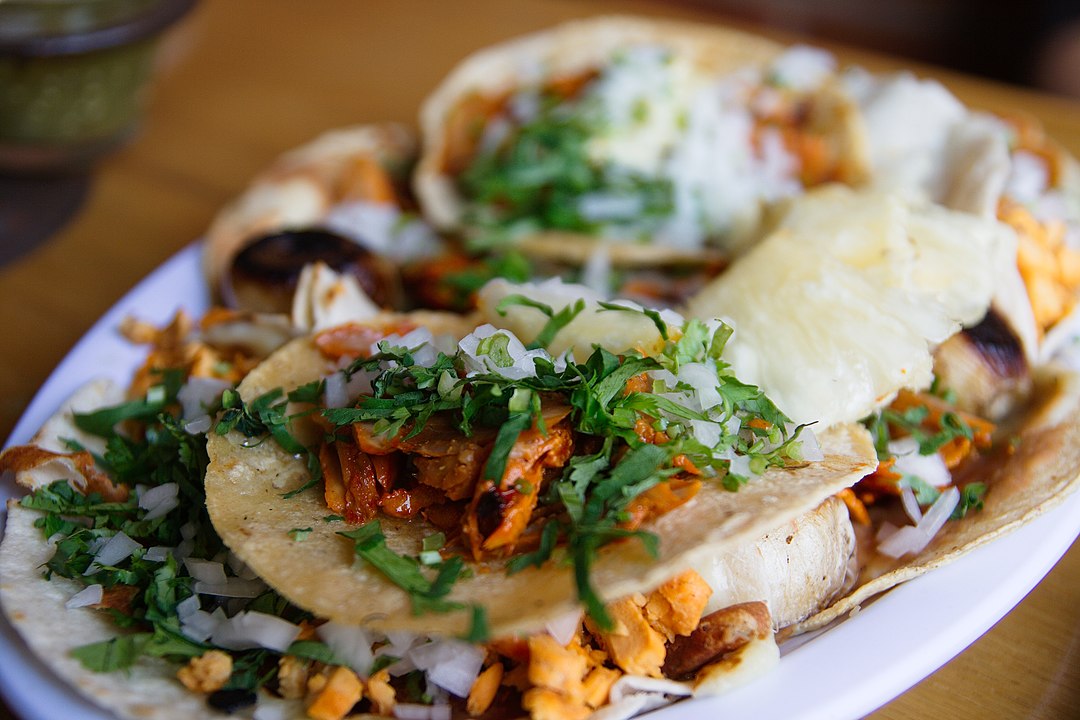
What is a Mexican taco?
The taco is a traditional Mexican food, that has two main ingredients – tortilla and filling.
The tortilla is a circular bread with a diameter between 5cm and 20cm and it is made of corn flour or wheat flour.
The filling could be very diverse. Usually, it is some kind of meat – pork, beef, chicken, and a salad garnish.
The extra ingredients that you can put on the tacos are:
-
Sauces – typically spicy sauces, but there are also more neutral ones.
-
Cream.
-
Salad.
-
Beans.
-
Nopales (cactus).
-
Rice.
-
Lemon.
-
Radish.
- Cheese.
Tacos al pastor – pork meat.
These are the most popular types of Mexican tacos in the whole Mexico. You can see taco stands in almost every street in Mexico City. From far, the tacos al pastor look like shawarma or döner kebab, because the chefs use the same kind of vertical grill. The truth is that the origin of this type of tacos is really the Middle East. Many immigrants from there, came to Mexico at the end of the 19th century and brought their food. The mixture with the Mexican culture and habits, change the lamb meat with the more popular in Mexico pork meat.
The meat that tacos al pastor have is spit-grilled pork. The typical marinate for the meat is chile guajillo or chile de árbol and other spices.
The garnish is onion, cilantro, lemon juice, pineapple, and great sauce (salsa verde) or red sauce (salsa roja). Everything comes inside delicious corn tortillas.
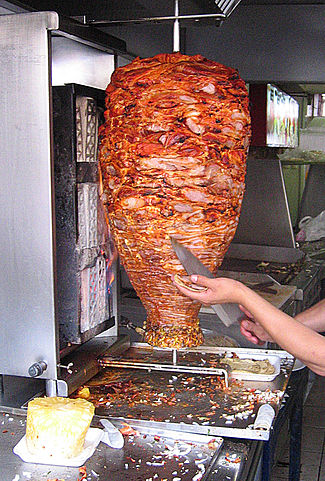
Tip: The taquero (the taco chef) will always ask you in the end “¿Con todo?” which means “with everything?". If you don’t like something, now is the moment to mention it.
Tacos Árabes – pork meat.
The tacos Árabes are almost the same as tacos al pastor. Again, they are pork meat, with onion, cilantro, and lemon. The main difference is the tortillas, which are wheat tortillas. The tacos Árabes are extremely popular in Puebla, a big city close to the capital.
Garnish – onions, cilantro, lemon, and cheese.
Tortilla – wheat.
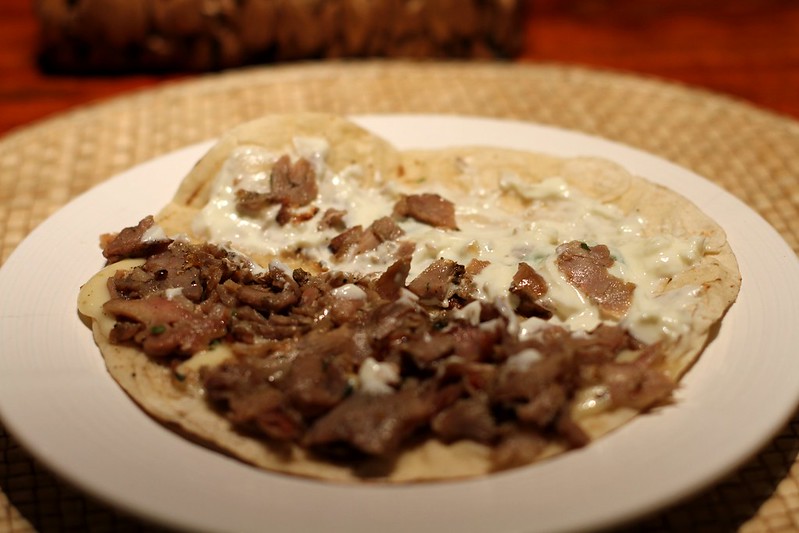
Bistec tacos – beef meat.
The bistec tacos (tacos de bistec) are one of the easiest to cook, but they are amazing! They are very thin beef stakes, prepared on a grill. The usual garnishes are small onions and cilantro, and corn tortillas. Simple but great option. The big difference here is the sauces. You can have a great taste if you put chipotle sauce on it. And to top it off, you can add manchego cheese too.
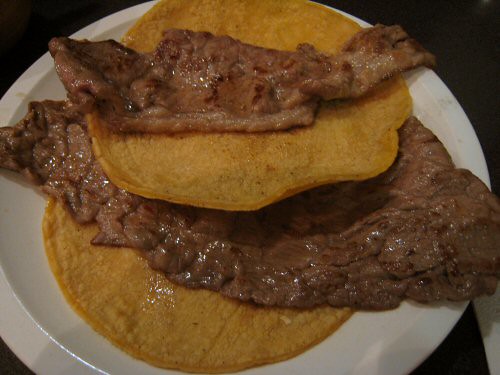
Arrachera tacos – beef meat.
Arrachera is another type of steak that is known as the hanger cut. The arrachera meat is very thin, and that makes it very easy and fast to cook on the grill. The secret to its taste is the marinade. It includes different citrus like lime and orange, garlic, cilantro, hot chilies, oregano, cooking oil, and black paper.
Garnish – onions, red peppers, cilantro, lemon, nopales (cactus).
Tortilla – corn or wheat.
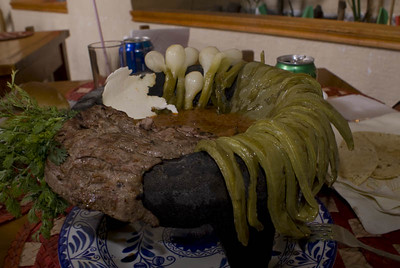
Carne asada tacos – beef meat.
When we talk about carne asada, it means that it is roasted. It is a marinated steak that gets its smoked flavor from charcoal. Otherwise, it is the same cow meat as the bistec tacos. You can find this kind of tacos more in the north. Monterrey is a great city to try tacos de carne asada.
Garnish – onion, cilantro, and hot sauce.
Tortilla – corn or wheat.

Cecina tacos – beef meat.
Tacos de cecina are very similar to those of bistec. Again, we are talking about beef meat, but this time it has a special process. The meat is dried and salted. These tacos are coming from the state of Morelos, near the capital Mexico City.
Garnish – nopales (cactus) and avocado.
Tortilla – corn.
Tip: Go to Yecapixtla (state of Morelos) to try tacos de cecina! I tried them there and fell in love with their taste.
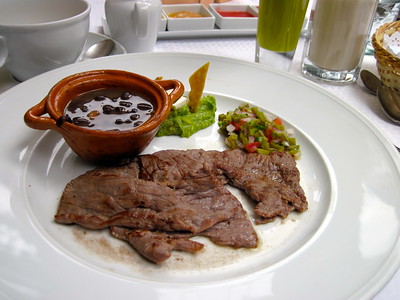
Tasajo taco – beef meat.
Tacos de tasajo are Spanish-style tacos from beef meat, very similar to cecina. It is dried beef meat, cooked on charcoal, and you can find them in most of the southern states like Oaxaca, Chiapas, Veracruz, and Campeche.
Garnish – onions, cilantro, lemon, beans and sauce.
Tortilla – corn or wheat.
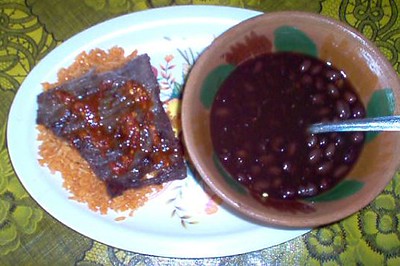
Machaca tacos – beef, pork.
The tacos de machaca are special types of tacos made from salted and dried meat (usually beef), that later gets re-hydrated just before cooking. The drying process happens in the desert, under the hot sun. The typical spices are salt and garlic.
The preparation comes from the state of Chihuahua. People there in the north, love to eat tacos de machaca with eggs for breakfast.
The taste is similar to jerky meat.
In the north, they prefer to prepare burritos, rather than tacos. The burritos are bigger breads, from wheat tortillas, that are wrapped around.
Garnish – onions, cilantro, lime, radish, avocado and sauce.
Tortilla – wheat.
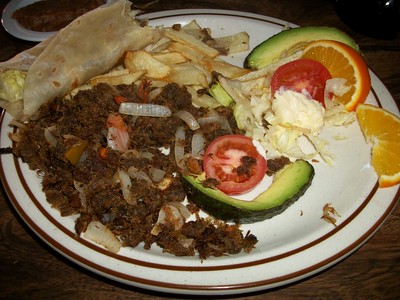
Chorizo/longaniza tacos – meat beef, pork.
Tacos de chorizo or tacos de longaniza are some of my favorite. They are sausage tacos. Chorizo is premium-quality sausage (ground meat), while the longazina (minced meat) is second-quality, but both are very tasty. They have amazing spices like oregano, cumin, coriander, and chili peppers. You can find them in most of the taquerias (taco stands).
Garnish – nopales (cactus), onion, and lemon.
Tortilla – corn or wheat.
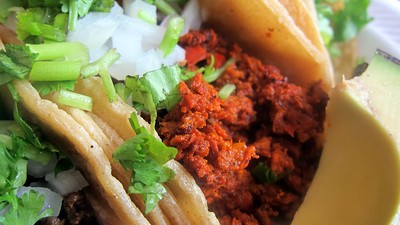
Moronga tacos – beef, pork.
The moronga looks very similar to the chorizo, but it is darker. The color comes from the fact that it is made of blood. It has a very strong taste, that is not liked by many, including me.
Garnish – nopales (cactus), onion, and lemon.
Tortilla – corn or wheat.
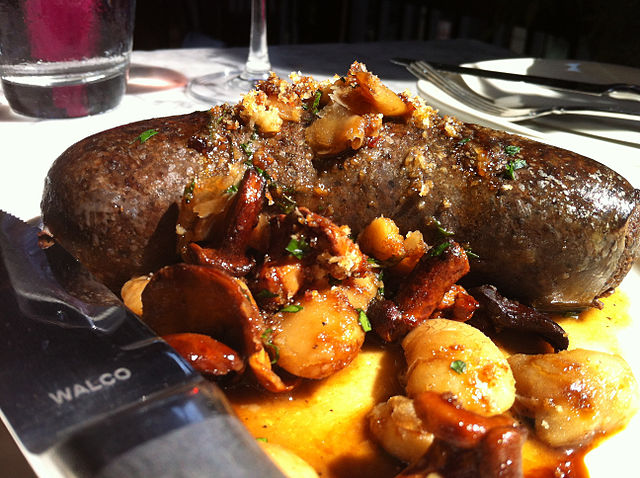
Campechano tacos.
Tacos Campechanos are mixing two great tastes – tacos de bistec with the tacos de chorizo. You can enjoy both steak and sausage in each bite! These tacos are amazing! As you can imagine, they are a bit more expensive, but if you are a real player, they are perfect for you
Put some cilantro and onions on top and a line of red sauce and taste paradise.
Garnish – onions, cilantro, and lemon.
Tortilla – corn or wheat.
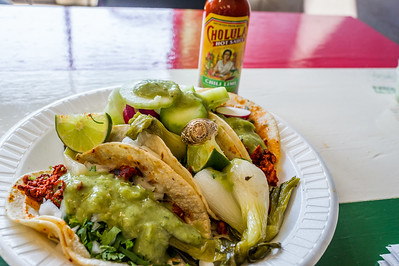
Suadero tacos – beef or pork.
The suadero tacos can be made from beef meat or pork meat, depending on the state of Mexico you are in. The meat itself is very similar to the bistec. It is again a flank steak, but this time the difference is the method of cooking. Suadero is prepared inside a lot of lard. The more greasy it is the better! This one is not for people on diets.
People in the capital loved them, especially in the late hours, after leaving a bar.
Garnish – onions, cilantro, and lemon.
Tortilla – corn or wheat.
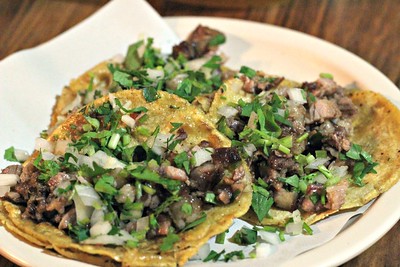
Carnitas tacos – pork meat.
Tacos de carnitas are pork meat tacos, from fatter cuts, cooked in a lot of oil. In such a taco you can find any type of parts from pork, even things like nose or tail!
They originally come from the state of Michoacán, but now you can find them in almost every state. It is a very beautiful state, near Mexico City.
For those of you, who are not very adventurous, it is better to skip this one.
Also, as you see, these tacos are very oily and they are not good for your health and diet.
Garnish – onions, cilantro, lemon, sauce, and avocado.
Tortilla – corn or wheat.
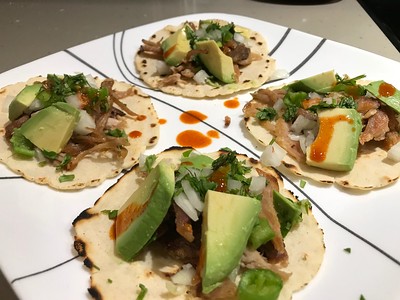
Barbacoa tacos – sheep or goat meat.
The traditional barbacoa tacos are prepared from really slow-roasted meat from sheep or goats. The meat stays in fire pits for hours, before it became extremely well cooked. At that moment, it can drop down from the bone without any effort.
You can find this type of tacos in small-town celebrations, important events like weddings, or another occasion with a lot of people.
Of course, you can find them in many taquerias in Mexico City too, no matter what day it is.
The tacos de barbacoa are very popular in the state of Hidalgo, where the people eat them accompanied by a soup (consomé).
Interestingly, these hard-to-cook tacos are mostly consumed in the mornings. In many places, you can’t find them after 2 pm.
Garnish – onions, cilantro, lemon, sauce, radish, and avocado.
Tortilla – corn or wheat.

Birria tacos – goat or beef meat.
The birria tacos come from the state of Jalisco. The birria is a type of stew, usually made from goat or beef meat. The spices that you can find in a typical Mexican birria are adobo chilli, onion, and garlic. Thanks to the adobo, the meat has a red color, so, in some places, they are called red tacos.
For some people, tacos de birria are considered low value, mostly because of their connection to drunk people. Mexican believe that eating greasy and spicy birria will remove the hangover.
Garnish – onions, cilantro, and lemon.
Tortilla – corn or wheat.
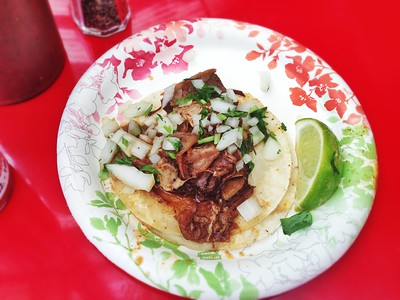
Cochinita pibil tacos – pork meat.
The cochinita pibil tacos of Yucatán, are a must-try if you are visiting Cancún. Cochinita means small pig and pibil shows that they are cooking in an underground oven.
They are made with slowly cooked pork meat, which stays a long time underground in a special oven until the meat becomes incredibly soft. The meat is marinated in citrus juice, made of limes, oranges, and many spices.
It is a bit like the barbacoa, but with pork meat. I prefer this one way more.
Garnish – onions, chile de árbol, habanero chilli.
Tortilla – corn or wheat.
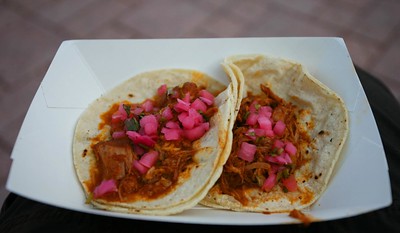
Lechón tacos – pork meat.
The lechón tacos are super similar to the previously mentioned tacos de cochinita pibil. And, as you could guess, they are also from Yucatán.
The tacos de lechón use the same technique for slowly cooking the little pigs. The pigs here are lechones, meaning that they are the youngest pigs (up to 1-month old) that are still eating milk from their mothers.
I didn’t find any differences, nor in taste, or look. Maybe I am not picky enough, but for me is the same meal as cochinita pibil.
Garnish – onions, chile de árbol, habanero chili.
Tortilla – corn or wheat.
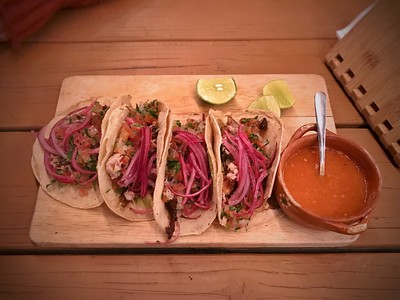
Tacos dorados – chicken, potatoes (VEGETARIAN), beef.
The tacos dorados, or golden tacos, are deep-fried tacos with different fillings like boiled potatoes, beef meat, chicken meat, or another. What is special about the way they are served is the fact that they are offered rolled up like a cigar, and on top of them, you get sour cream, fresh lettuce, and white cheese. Depending on the size, they might be called taquitos dorados (small tortillas), tacos dorados (normal tortilla size), or flautas (long tortillas)
If you are a vegetarian, you can get an order of tacos de dorados "de papas". For the vegan, this one does not work, because it is fried and served with sour cream.
Garnish – lettuce, sour cream, white cheese (usually Panela cheese).
Tortilla – corn or wheat.

Tacos de mixiote – beef, pork, sheep meat.
Mixiote sounds very Mexican and it is. It uses an old method of slow cooking in a fire pit, like the barbacoa. Mixiote means mixed and they are a combination of beef, pork, and sheep meat. Perfect for the indecisive people who can’t decide on the type of meat they want.
The meat is cooked with a variety of spices, and chillies, so in the end, you have very juicy meat.
The mixiote tacos are popular in Mexico City, the nearby state of Hidalgo, and also Guerrero (Acapulco).
Garnish – beans, avocado, nopales (cactus), sauce.
Tortilla – corn or wheat.
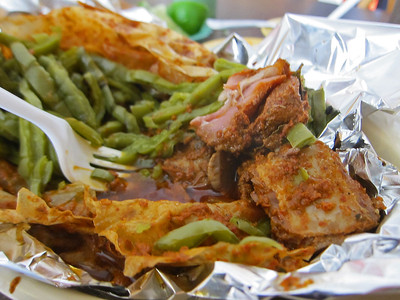
Tinga tacos – chicken meat.
Tinga tacos are chicken tacos, from meat that is shredded to strings. Tinga means torn. What is great about them is that they are cooked with chipotle chilli, tomatoes, and onion and have an amazing taste. It is a simple, yet delicious choice.
Garnish – onions, cilantro, lemon, and sauce.
Tortilla – corn or wheat.
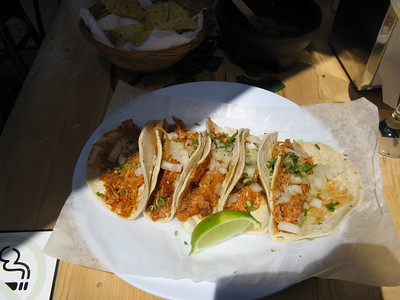
Tacos de Canasta – pork, beef, beans, potatoes, chicharrón prensado.
Tacos de canasta or basket tacos are some of my favorite. You can see the cool guys, going all around the capital city on their bicycles, and selling you straight from the basket.
Canasta tacos are cooked on vapor for many hours, and that gives them their very soft touch.
Some say, that the tacos de canasta come from Tlaxcala state, but you can find them in many states including the capital.
You can find many different tastes:
- Tacos de canasta de frijol – bean tacos with onion. These are 100% vegetarian and even vegan.
- Tacos de papas – boiled potatoes tacos with onion. Another vegetarian and vegan option!
- Tacos de chicharrón – tacos from the fried skin of pigs, cooked in green or red sauce.
- Tacos de chicharrón prensado (compacted or pressed) – frying remains gotten from the bottom of the saucepots where the crunchy chicharrón is fried. These remains are fried again and pressed a little to compact them and remove some of the fat. It is dark brown when it is finally fried.
- Tacos adobados – beef tacos with onion and guajillo sauce
- Tacos de mole verde – chicken meat and green sauce.
- Tacos de picadillo – minced meat, boiled potatoes, and carrots with spices.
- Sauces – salsa verde (green sauce), or salsa roja (red sauce).
Tortilla – soft corn tortillas.
Tip: These tacos take a long time to prepare and go on sale from early morning. Buy them during the day, because in the afternoon, they might not be in their best condition and could be a health hazard.

Guisados tacos – beef, pork, vegetarian (in some cases).
Tacos de guisado are tortillas with different prepared food inside. The traditional tacos de guisado are made of stew from meat and vegetables. Between the many varieties of these tacos, you could try the following:
-
Rice and eggs.
-
Nopales (cactus) and onions. This one is vegetarian and could be even VEGAN!
-
Eggs with tomato sauce.
-
Rajas (chilli) with cream.
-
Picadillo – potatoes, carrots, and minced meat.
-
Chicken with chipotle sauce.
Tip: Always ask what the guisado is. If you are a vegetarian, you might find very good meals. Even vegans might have a chance to eat.
Tortilla – corn or wheat.
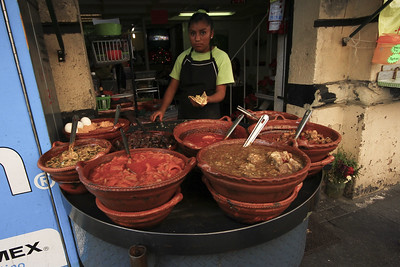
Chicharrón taco – pork meat.
Chicharrón is deep-fried pork skin, that becomes crunchy like chips. The most typical type of taco de chicharrón is prepared in green sauce (salsa verde). The chicharrón becomes soft and incredibly tasty. You can add onion and cilantro on top, to have a perfect culinary experience.
This is one of the not-so-traditional meats, but I can recommend it with two hands!
You can find it made with different sauces like the red one, chipotle, guajillo, and others.
Garnish – onions, cilantro, lemon, and sauce.
Tortilla – corn or wheat.
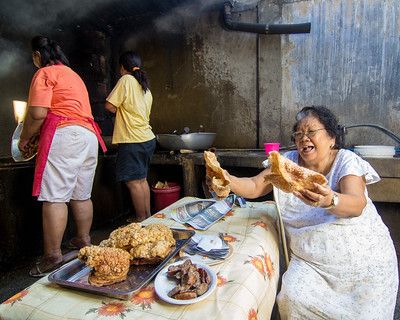
Cabeza tacos – beef meat.
Tacos de cabeza, are made of the meat from a cow’s head. I know, some of you might directly skip this one, but if you insist on trying it, you will get small pieces of meat of chicks, cow’s ears, nose, and more. The only thing that you won’t find here is the tongue, which Mexican separates for another taco (taco de lengua).
So, the head is slow-cooked, in a very big pot with many spices.
I don’t like these ones, but they might be your favorite, who knows.
Garnish – onions, cilantro, and lemon.
Tortilla – corn or wheat.
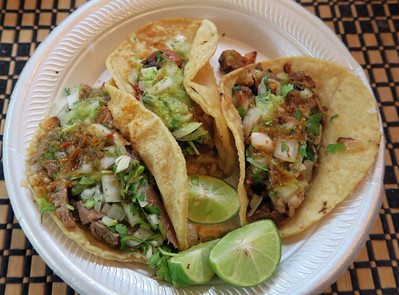
Lengua taco – beef meat.
If you read the last one, now you know where the cow’s tongue goes, to the lengua tacos. The meat of the tongue is a bit harder to chew and has a very specific texture. It is not for anybody’s taste for sure. For me, it was a one-time try, and honestly, the tacos de lengua were not bad, but you can get better at the same price.
Garnish – onions, cilantro, and lemon.
Tortilla – corn or wheat.
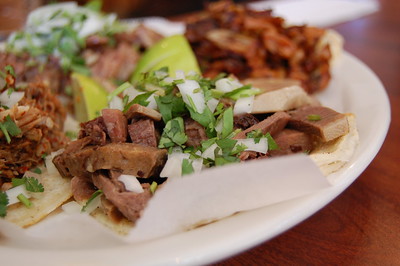
Tacos de panza – pork meat.
Tacos de panza are tacos from the belly of a pig. When you are trying less common parts of animals you always get doubts. The taste is strange, and not everybody likes it, me included. The panza (belly parts) are tough to chew and not very tasty. Such a meal is usually offered with a very strong hot sauce, which further kills the taste.
Garnish – onions, cilantro, lemon, and sauce.
Tortilla – corn or wheat.
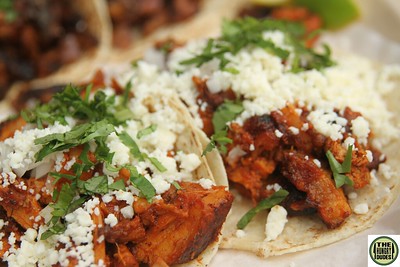
Tacos de tripas – beef meat.
If you didn’t like tacos de panza, you will like tacos de tripas even less. The tripas are intestines of the animal (cow). The intestines are well cleaned, and then boiled for hours. After that, they are cooked in their own fat until they get to a rubbery texture. These tacos are also offered with a very hot sauce.
I personally don’t recommend them. They just didn't taste good for me.
Garnish – onions, cilantro, lemon, and sauce.
Tortilla – corn or wheat.
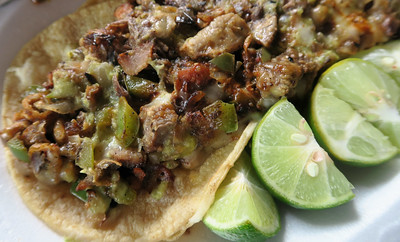
Pescado – fish.
The tacos de pescado are fish tacos. You can find them on every beach place. Cancún (Yucatán), Playa del Carmen (Yucatán), Puerto Escondido (Oaxaca), Acapulco (Guerrero), Puerto Vallarta (Jalisco), Los Cabos (Baja California), and others have their version of pescado tacos. Each place has a bit different method of preparation, but the most common is to fry the fish and add hot sauce. The garlic is also a very common ingredient, together with cilantro, lime, habanero chilli, mayonnaise.
The most common tacos de pescado are:
-
Tacos de Marlin fish (Tacos de pez espada) – smoked swordfish tacos. Expensive, but delicious.
-
Tacos de filete frito de angelito – shark tacos.
-
Tacos de cazón – small shark from Veracruz.
-
Tacos de bacalao – cod fish tacos.
-
Tacos de tilapia – tilapia tacos. You will find this one commonly written as filete, in the menus.
-
Tacos de magro – white fish taco. It could be any of the following acedia, abadejo, besugo blanco, coruxo, merluza, rodaballo salvaje.
-
Tacos de atún – tuna fish tacos.
-
Tacos de salmón – salmon tacos. These are a bit oily but very tasty.
-
Tacos de bagre – catfish tacos.
-
Tacos de mantarraya – manta ray tacos.
Tortilla corn and wheat.
Tip: If you want to enjoy a fish taco, go to the beach. Yes, you can find fish tacos in the capital or any other big city like Monterrey or Guadalajara, but the fish won’t be as fresh as on the seaside.
Also, evade the pescadillas (quesadillas de pescado) that you will see on every beach. The sellers offer them all day, and the sun can really damage them, and poison you when you eat.
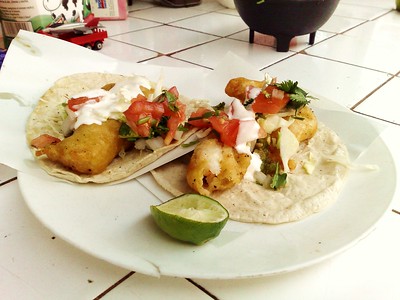
Tacos de mariscos – sea food.
Tacos de mariscos unite all of the seafood – fish, octopus, calamari, oysters, etc. Many times, these tacos are a mix of everything that the restaurant has at the moment, so if you want to get more information, ask “¿De qué son?”. Mexico has a lot of seafood. It is on two oceans – the Atlantic and the Pacific. The garnish here is again lime, hot sauces, mayonnaise, onion, avocados, and more.
There are plenty of choices and really fresh seafood. What you can see in the restaurants’ menus are:
-
Tacos de ostiones – oisters tacos.
-
Tacos de calamar – calamari tacos.
-
Tacos de camarón – shrimp tacos.
-
Tacos de pulpo – octopus tacos.
Tortilla corn and wheat.
Tip: Just like the fish tacos, evade seafood tacos if you see that the sellers or the restaurants don’t look like they are keeping the seafood in a proper environment. Eating bad seafood can lead to at least a few days of diarrhea, and that could easily ruin your fun beach trip.
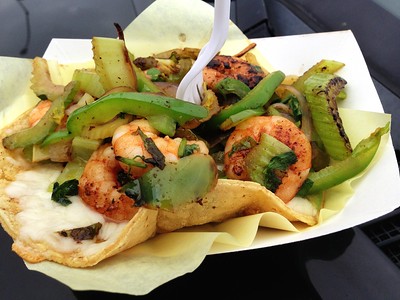
Tacos de chapulines – grasshoppers tacos.
Yes, you read this one right. Mexicans eat grasshoppers! They put them in tacos, add some delicious sauce on top and enjoy a crunchy snack. I have tried these ones and I really like the taste of the grasshoppers. For me, they are like chips with salt and lemon.
Funny story with these tacos de chapulines. One Time I ate some from a food truck in Mexico City and I sent a picture to my grandmother in Bulgaria. She got extremely shocked by the grasshoppers. She told me that if I am so poor that I am eating insects already, it is time to come back.
She said that she will buy me a ticket and cook me whatever I desire!
Garnish – onions, cilantro, avocado, sauces.
Tortilla – corn or wheat.
Tip: If you don’t feel brave enough to try, just close your eyes and imagine they are deep-fried potatoes.
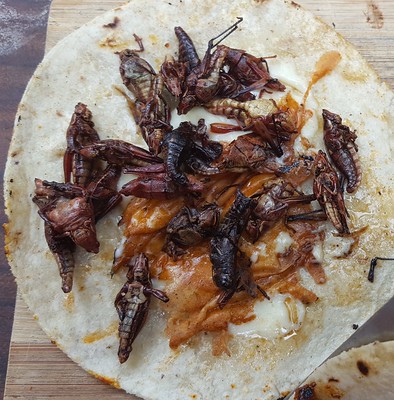
Tacos de maguey – maguey worm tacos.
Sure, why not? If Mexicans eat grasshoppers, what could stop them from eating worms too? The maguey worm eats agave plants. This is the reason that you can see these tiny worms inside tequila and mezcal bottles. The Mexican thought, if the worms eat just agave and we already put them inside our drinks, why not put them on our pans? They deep fry the maguey worm with spices and lime and serve it inside a tortilla with guacamole sauce.
It is not for anybody’s taste, but if you are passing through Oaxaca or Jalisco, it won’t kill you to try tacos de maguey.
Tip: If you like alcoholic drinks, you can get a shot of tequila or mezcal to get the courage to try the worm tacos!
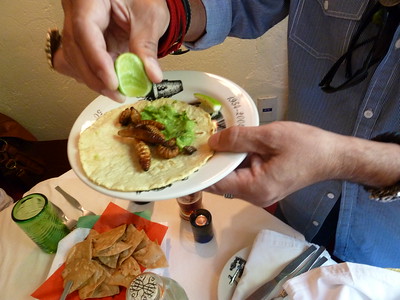
Tacos de escamoles – insects eggs tacos.
The escamoles are insect eggs, mostly ant eggs, and people called them the Mexican caviar. It sounds really strange to eat ants eggs, but you can imagine that there are a lot of proteins inside them. They are prepared with spices and butter and are considered an expensive delicacy.
I have tried them, and I can say that you mostly taste the spices, and the eggs feel just like a small exploding ball inside your mouth. Try, if you want to brag that you have tried everything, otherwise, there are far more delicious options for tacos.
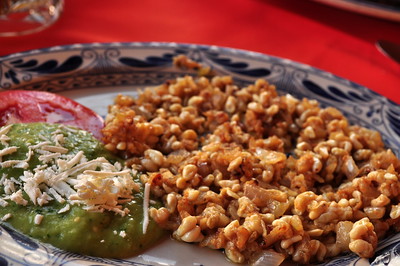
Tacos de ahuatle, huevos de mosco – mosquito eggs tacos.
Ahuatle or huevos de mosco are eggs of mosquitoes, the annoying insects that bother you while you are trying to sleep. Eating their eggs inside a taco could be nice revenge! I tried tacos de ahuatle in Xochimilco in Mexico City, and I didn’t like them at all.
How to choose the best Mexican tacos?
-
Don’t buy tacos, or any other Mexican food inside, or near a metro station. The quality there is very low, and it is not worth trying. Yes, you can get a few tacos for less than 50 pesos, but that comes in a price of stomach pain, and hours in the toilet. Besides, you can get a very bad impression of what Mexico can offer.
-
Most taco stands and authentic small restaurants are fine. You can eat without worries about your health. If your belly is really delicate then go to a big Mexican restaurant or any of the restaurant chains like El Porton, Potzollcalli, Vips, Toks, El Tizoncito, or Sanborns.
-
Try the chilli sauce, before you spread it all around your dish. Many times, the hot sauce could be really strong. Especially if it is chile de árbol or chile habanero. Try before, so you don’t cry later!
-
Don’t eat tacos de canasta in the afternoon. I am speaking here from experience. Once I ate some tacos de canasta de chicharrón and my belly was hurting for days! The taco de canasta sellers go out early in the day, and they don’t keep their tacos in a fridge. Just in a normal basket. Mexico is hot so you can get all kinds of intestinal infections.
-
Ask the locals. When you are visiting Mexico, you must get to know the local people. They are incredibly friendly and always ready to help a tourist. Ask them, which are their favorite taco places, and in many cases, they will be happy to show it to you.
Conclusion.
Wow! There are so many types of Mexican tacos out there! My favorite are tacos al pastor, especially after leaving a nightclub. But also I love tacos de bistec, tacos campechanos, and tacos de cecina. It is a shame that you can’t find true tacos outside of Mexico.
Now that you can finally understand the menu in a Mexican restaurant, which one are you eager to try? Don’t be shy, get your order now. And put some sauce on them!
Share your experience with us, PackandGo.info
| Follow PackAndGo.info at: | |
| YouTube | @packandgo. |
| @packandgo.info | |
| X | @packandgoinfo |
| Bluesky | @packandgo.bsky.social |
| @packandgo.info | |
| TikTok | @packandgo.info |
If you want to know more about the tacos see this article "Everything you wondered about tacos, answered".
Why do Turkish, Greek, and Bulgarian tourists love Haskovo?
- Details
- Written by: Martin Pramatarov
- Hits: 1394
At first glance, Haskovo is just a little town in south Bulgaria. What could possibly bring thousands of tourists from Turkiye (Turkey), Greece, and Bulgaria to this place? It turned out there are a lot of things to do in Haskovo!
Where is Haskovo?
Haskovo is located in south Bulgaria in the region of Thrace. You can go to Haskovo, in less than an hour, from the Turkish border and just under 2 hours from the Greek one. This is why it is really easy to visit Haskovo from Turkiye or Greece.
Ok, it’s is not far, but why should you visit it?
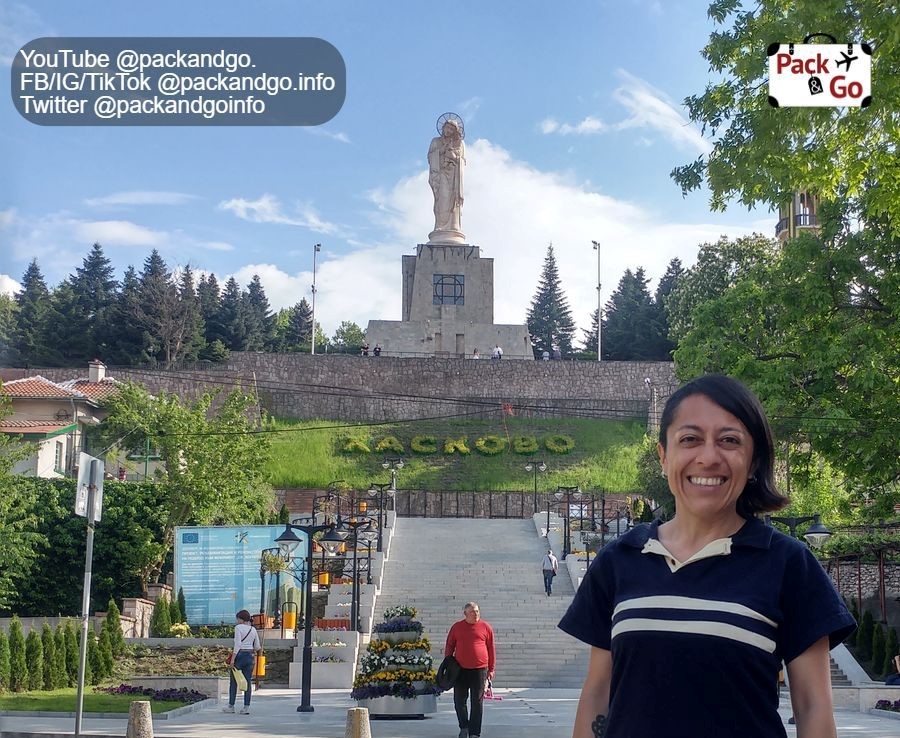
What to do in Haskovo?
There are many things to see in Haskovo. You can easily spend a weekend or even a full week in Haskovo and its surroundings, without getting bored.
Haskovo’s top attractions:
-
The monument of the Virgin Mary
-
Haskovo’s Bell Tower
-
San Stefano Street in Haskovo
-
The Monument of Envy
-
The Regional Historical Museum of Haskovo
-
Old Haskovo Clock Tower
-
1000 years Haskovo monument
-
Kenana Park
See the monument of the Virgin Mary (Monument of the Holy Mother of God)
Haskovo’s statue of the Virgin Mary is so monumental that it holds the Guinness world record for the highest monument of the Virgin Mary in the world. It is 32.8 meters high! What is so great about it is that it is located on a hill, so when you climb on it, you can see the whole Haskovo city.
Inside the statue, there is a small chapel called “Nativity of the Blessed Virgin Mary”. Greek tourists like to put candles inside the chapel.
The Virgin Mary statue is located inside Yamacha Park. There you can spend the whole afternoon, having a nice picnic or just a walk. And just next to the monument of the Virgin Mary, there is the Bell Tower of Haskovo.
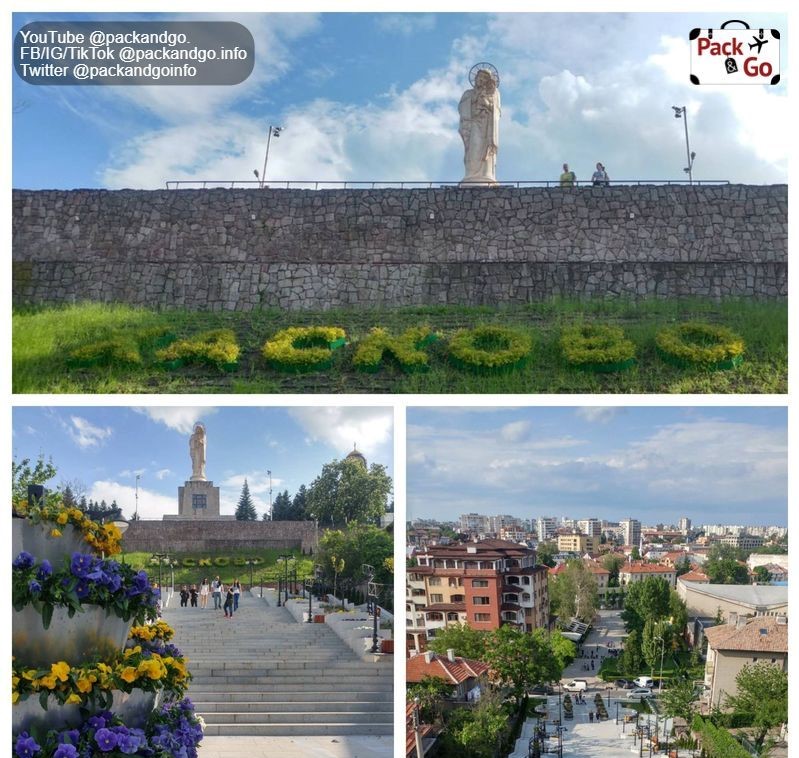
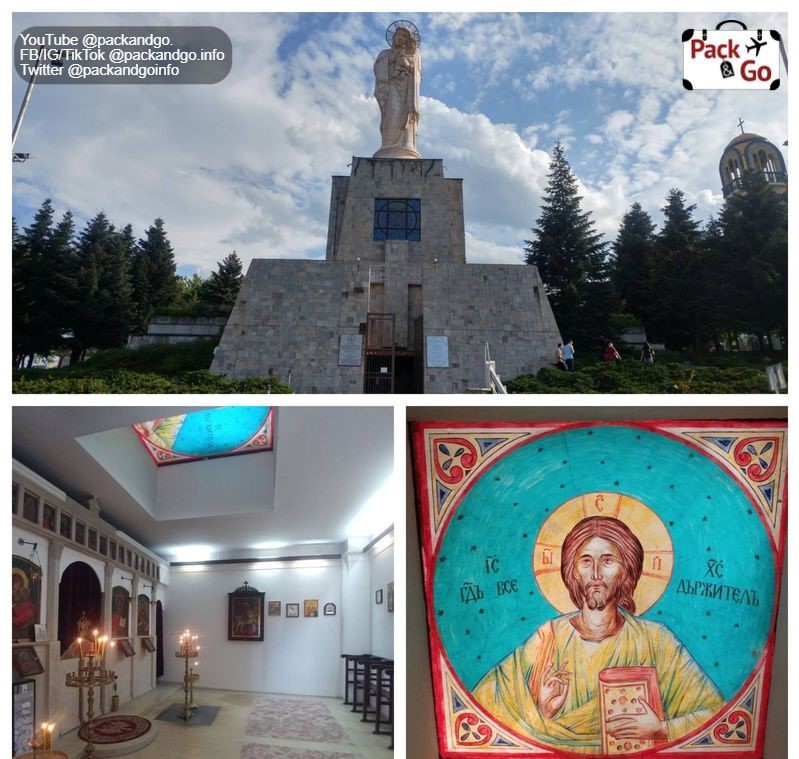
Climb Haskovo’s Bell Tower
Inside Yamacha Park, just next to the Monument of the Holy Mother of God, you will find a beautiful Bell Tower. From the moment we saw it, we wanted to climb it. Of all the things to do in Haskovo, this one is a must. It has the best possible view of Haskovo. But there is a catch. Haskovo Bell Tower is a working clock tower. It rings the bells every hour, and there is nothing to stop you from climbing to the bells. Only a small sign in Bulgarian saying not to climb when it will ring. We arrived 10 minutes before the next ring. This pushed us to climb the tower in a hurry. We managed to do it and have a few photos from the top. Then it was a dash to the ground. Just as we sat on one bench below the Bell Tower started ringing. It has a powerful sound. I was glad we managed to get down on time or we could easily get deaf from the loud sound. Seriously, don’t stay up when it is ringing. It could be very harmful for your ears.
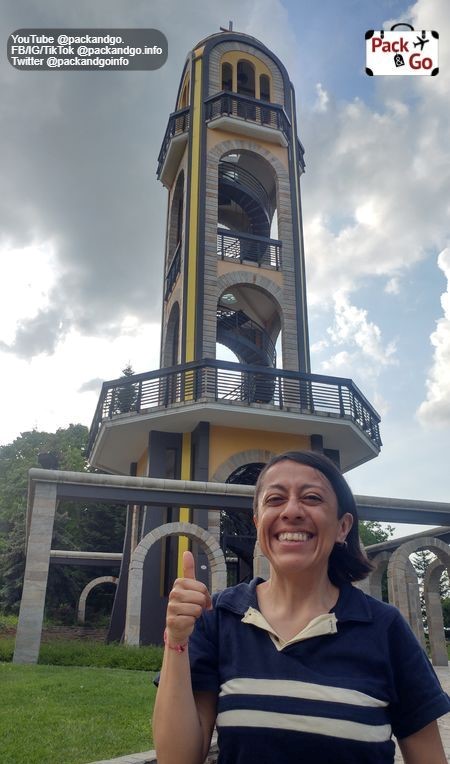
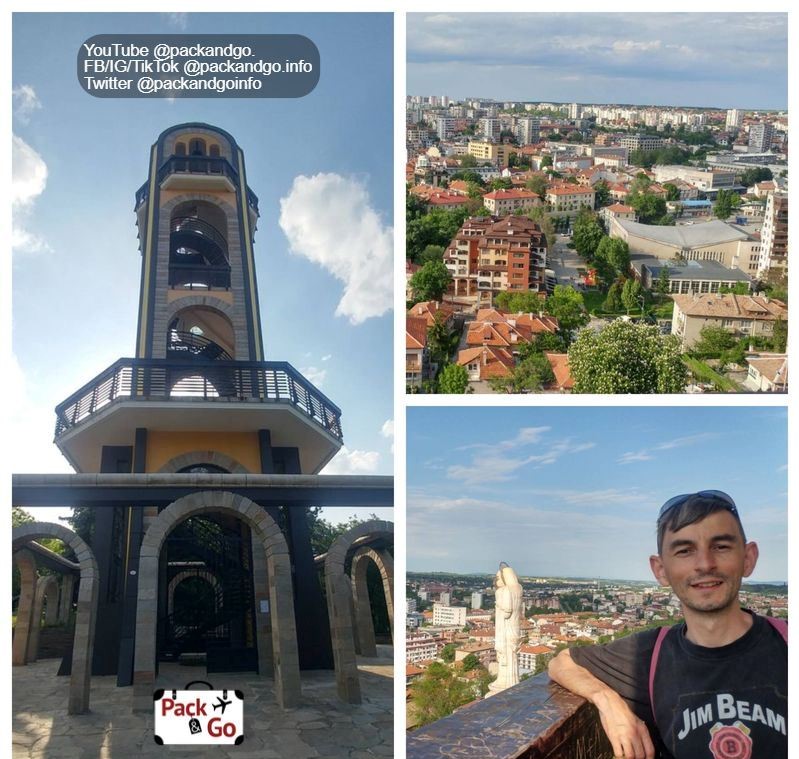
Walk on San Stefano Street towards the downtown of Haskovo
Start from the monument of Kapitan Petko Voyvoda and walk toward Obshtinski Square.
There you can find plenty of coffee places, restaurants, and fast food stands. We enjoyed a lot how lively this part of Haskovo was. You see people of all ages enjoying their time. If you are into Greek gyros or Turkish doner kebab, there are many options on the street.
The walk to the center of Haskovo is short, maybe around 10 minutes, but it is really pleasant. In the end, you will see the start of Obshtinski Square and the Monument of Envy.
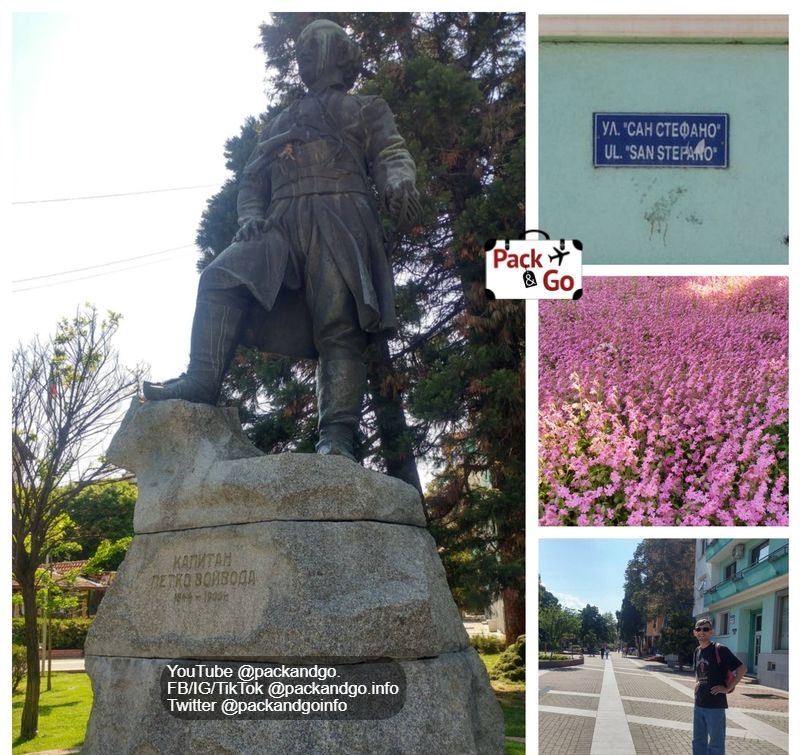
Rest next to the Monument of Envy in Haskovo
The people from Haskovo are really proud of this monument. They say it is the only monument of Envy in the whole world. We can’t guarantee that, but it is not common when somebody creates a monument of a negative feature.
The monument of Envy in Haskovo represents a successful man, that has spread his wings and he is ready to fly high. But there is an ugly, skeleton hand, that drags him down, in an attempt of stopping him. With his sculpture, the author Gospodin Tenev (Guspata), wanted to say that there will always be envious people trying to stop you. And actually, you should embrace it. When the “ugly” people start to bother you, you should know you are on the right path to greatness.
Why should you see it? Because it is truly inspirational. Don’t give up when envious people come into your life. Fly away and resist the negativeness.
We got an ice cream from Billa and had a nice break next to the statue. On a hot day, ice cream and the drops from the fountain were a great combination.

Visit the Regional Historical Museum of Haskovo
If you are into museums visit the Regional Historical Museum of Haskovo. Why? Bulgaria has a rich history dating back to the stone age. What is interesting about Haskovo’s history is that it is located in the geographical area of Thrace. You can find some truly ancient artefacts from the Neolithic age (between 8000 to 5000 years BC!). You can explore history through all the tools that are still well-preserved. Going from stones to primitive metal tools and finishing in the middle ages.
Greek, Turkish, and Bulgarian tourists can enjoy the Regional Historical Museum in Haskovo, and see how these countries and their cultures have been intertwined together for many ages.
The entrance costs 2 BGN (around 1 euro) for adults and half price, 1 BGN for children and pensioners. It is worth it.
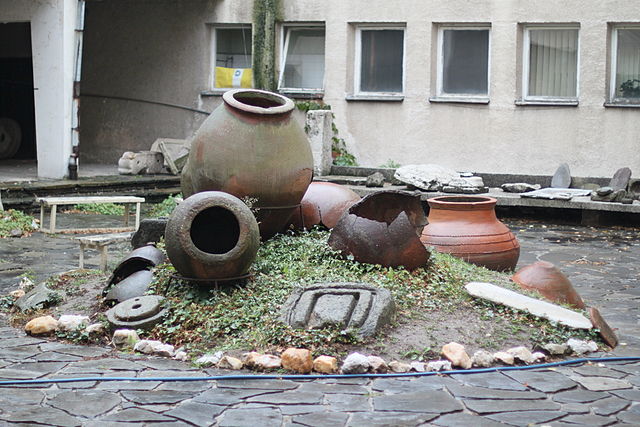
Check out the Old Haskovo Clock Tower
In Haskovo, you don’t need a watch, you can see the time everywhere. The Old Clock Tower of Haskovo was built at the beginning of the 19th century and still shows the time, in the center of the city. It is a 23-meter high Clock Tower, with a recently updated mechanism and the bell, created by the same company that built the Big Ben bell in London.
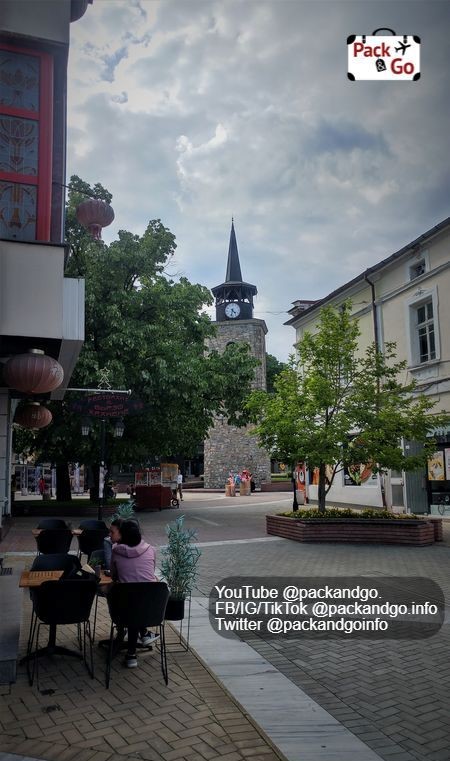
Eat Bulgarian food
We can’t just walk all day without getting hungry! Enjoy some traditional Bulgarian food in Haskovo. Here, you can enjoy a great fusion between Bulgarian, Turkish, and Greek cousins. You will find Pide, Musaka, different kebabs, Lahmacun, Kiopoolu, Banitza, filled paprikas with minced meat and rice, sarma, and more. Just writing these incredible foods makes me hungry.
Of course, there are pizzas and burgers, just like anywhere in the world, but Haskovo has great local food too. Try it out! Broaden your culinary culture!
| Follow PackAndGo.info at: | |
| YouTube | @packandgo. |
| @packandgo.info | |
| X | @packandgoinfo |
| @packandgo.info | |
| Bluesky | @packandgo.bsky.social |
| TikTok | @packandgo.info |
Check out the 1000 years Haskovo monument
While you are in the center of Haskovo, take pictures of the 1000 years of Haskovo monument. Here in this city, people love clock towers, so you can enjoy one more. It is a high building, 26.5 meters and it has a very cool design. It looks heavy, industrial and somehow reminds me of the Transformers.
The idea of the monument was to show the 4 directions of the world and to represent that Haskovo is on the way between the East (Asia), and West (Europe).
Sadly, tourists can’t climb on it.
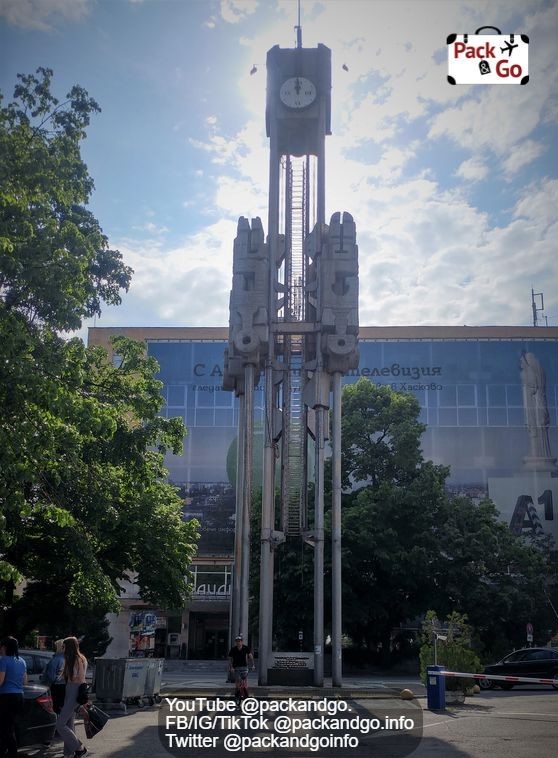
Park Kenana (Lesnopark Kenana) and Haskovo Zoo (Kenana Park Zoo)
Do you fill like going into the forest? Lesopark Kenana gives you a great opportunity to do it. It is big and perfect for a walk with your family or pet. Kenana Park is both pet-friendly and kid-friendly. It is your escape from the city. It is located in the north part of Haskovo. You can easily arrive by car or public transport.
We saw many people that come to do their exercises here. Runners, cyclists, tennis players, yoga people and more.
In this forest environment, there is a small zoo too, the Kenana Park Zoo. With animals, typical for the Balkan forest like deer, rabbits, ducks, wolves, and more. The big exception is the lions. They look a bit out of place here, but the locals love them.
Bear in mind that there are no businesses inside the park. You need to prepare yourself with food and drinks.

What to visit near Haskovo?
There are a few truly interesting places you can visit near Haskovo. Some will help you discover more about the history of the region, and others, will just feel your heart with joy from the nature’s beauty.
Top attractions in Haskovo’s surroundings:
- Historical museum Dimitrovgrad
- Thracian tomb of Aleksandrovo
- The Stone Mushrooms
- Perperikon (Perperek)
Historical museum Dimitorvgrad - 14 km away
You should visit it because you can learn more about the socialist past of Bulgaria. “Brigadier Movement in Bulgaria" hall focuses exactly on this period. You will see old uniforms, flags, different signs, photos, and awards from the Brigadiers' past.
The entrance is just 2 BGN for adults and half price (1 BGN) for children and pensioners.
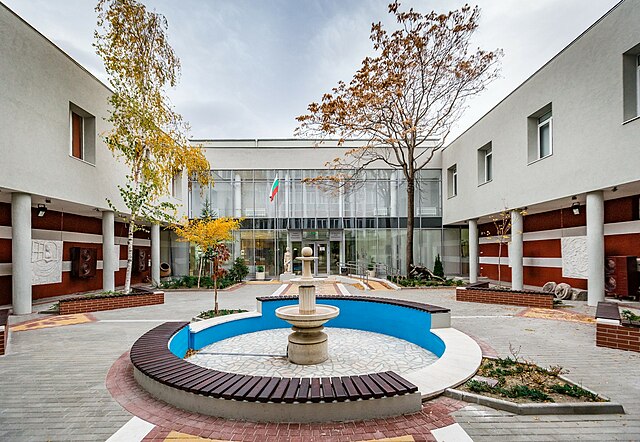
Alexandrovo Tomb (Thracian tomb of Aleksandrovo) – 16 km away
The Alexandrovo Tomb is an ancient Thracian tomb from the 4th century BC. The name of the ruler, resting in it remains a mystery. This is why some people speculate that it is the grave of Alexander the Great. He also died during the 4th century BC, and Macedonia is close. There are some chances this myth is true.
Even if the Tomb in Alexandrovo is not Alexander the Great’s tomb, you can still see some really unique artefacts like the Thracian frescos and amazing tomb architecture. A funny fact is that in one of the frescos, one participant in a hunt wears Greek sandals. This obviously shows how strong the Greek influence was in this region.
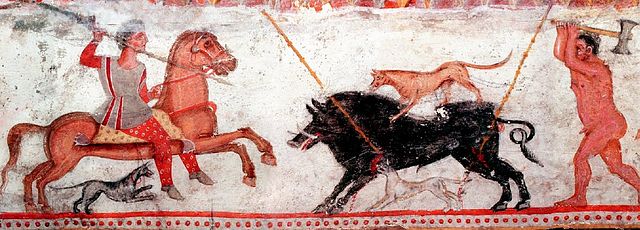
The Stone Mushrooms (Mushroom rocks) – 20 km away
The Stone Mushrooms is a unique rock phenomenon near the village of Beli Plast, between Haskovo and Kardzali. On our way to Kardzali, we stopped to check it out. The stones have a very extravagant form, that strongly resembles mushrooms. This is why they are called the Stone Mushrooms.
They are created from volcanic tuffs (learn about volcanos) rocks and have cool colors like pink (mineral cloinoptilolite), blue and black spots from manganese, and even green colors from the mineral celadonite.
Each stone mushroom is around 2.5 to 3 meters high, and there are more than several rocks around.
If you are into cool rock formations, you can also check Belogradchik, or Sliven, and its blue rocks.
There is no entrance fee for the Stone Mushrooms near Haskovo. They are free to visit.
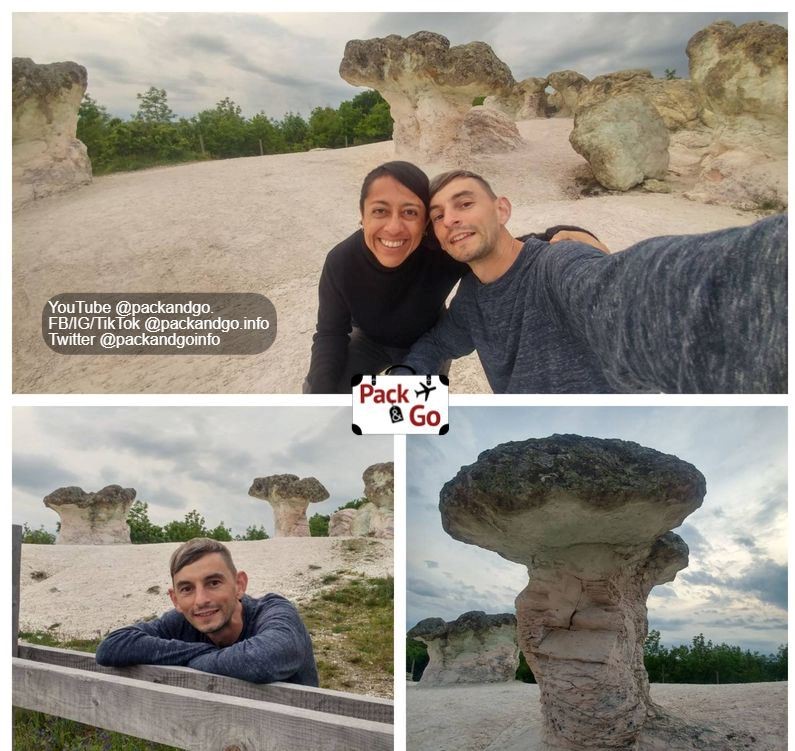
Perperikon (Perperek) – 25 km away
Peperikon is another must-see landmark in Bulgaria. It is a Thracian holy place from 6 000 years BC! An ancient place! Currently, there are remains from the last middle age settlement there and a beautiful stone tower.
Thousands of tourists come to Perperikon, not only from Turkiye and Greece but also from all over the world.
Honestly, you can reach it from Haskovo easily, but it is just a bit closer to Kardzali. So if you want to know more about it, check out our Kadzali article (LINK).
Outro
So, what are you waiting for? You saw the pictures from Haskovo already.
If you are in Edirne, it is closer to come here than to go to Istanbul. It will be a whole new country with a different language and culture.
For Greeks, there are also many things to see in Haskovo. Greece is old, but Thrace has a lot of history too.
There are plenty of things to do in Haskovo. Just visit Haskovo already!
How to get to Haskovo?
From Turkey to Haskovo:
The distance between Edirne and Haskovo is just 100 km and it takes only hour and a half to get there. Check the navigation here.
The distance between Tekirdag and Haskovo is 250 km and it takes 3 hours to get there. Check the navigation here.
The distance between Istanbul and Haskovo is 345 km and it takes 4 hours to get there. Check the navigation here.
Turkish citizens must obtain a Bulgarian visa, before their trip. The process is not hard and it gives you the right to stay up to 90 days in Bulgaria. You can get a visa at the Bulgarian consulates or embassies in the following cities: Ankara, Bursa, Edirne, and Istanbul.
Check out how to get a Bulgarian visa here (LINK).
From Greece to Haskovo:
The distance between Komotini and Haskovo is just 118 km and it only takes 1 hour and 52 minutes to get there. Check the navigation here.
The distance between Alexandroupoli and Haskovo is 172 km and it takes 2 hours and a half to get there. Check the navigation here.
The distance between Kavala and Haskovo is 215 km and it takes 2 hours and 50 minutes to get there. Check the navigation here.
Greek people only need their ID cards or passports to cross.
For tourists within Bulgaria:
And of course, you can get easily get to Haskovo from different Bulgarian cities:
The distance between Kardzali and Haskovo is just 47 km and it takes only 45 minutes to get there. Check the navigation here
The distance between Stara Zagora and Haskovo is just 60 km and it takes only ah hour to get there. Check the navigation here
The distance between Plovdiv and Haskovo is 96.4 km and it takes 1 hour and 10 minutes to get there. Check the navigation here
The distance between Sliven and Haskovo is 136 km and it takes 1 hour and 40 minutes to get there. Check the navigation here!
| Follow PackAndGo.info at: | |
| YouTube | @packandgo. |
| @packandgo.info | |
| X | @packandgoinfo |
| @packandgo.info | |
| Bluesky | @packandgo.bsky.social |
| TikTok | @packandgo.info |
If you haven’t tried mezcal, you haven’t lived
- Details
- Written by: Gianna Esquivel
- Hits: 1241
If you haven’t had mezcal yet, that is what Mexicans and mezcal enthusiasts will tell you. “If you haven’t tried mezcal, you haven’t lived”. I can’t be objective here. I totally agree with them. Mezcal is a delicious beverage. Once my palate tried its smoked notes, it got in love with them. For me, there’s no way back! I want mezcal in my life.
Mezcal is a Mexican agave spirit that has existed for centuries but now has become more popular. There’s no doubt, agave is a very generous plant. It is the source of really delicious alcoholic beverages that are icons of Mexican culture. Tequila (What is tequila?) is very well known around the world and mezcal has arguments enough to convince and get your palate and heart!
Let’s explore the origin, features, and more aspects that can make you crave a delicious mezcal.
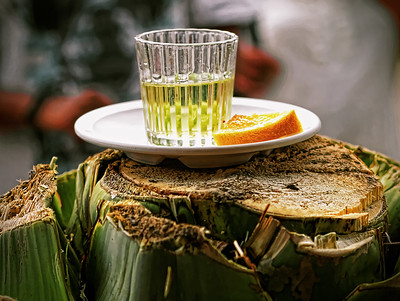
What is Mexican mezcal?
Mexican mezcal is a popular spirit distilled from agave. It is a beverage with a specific smell and flavor, colorless or slightly yellowish when it’s rested, aged, or when it’s abocado.
Abocado refers to the addition of one or more natural products, flavorings, or colorings allowed in the corresponding legal provisions to soften its flavor, without resting it or aging it.
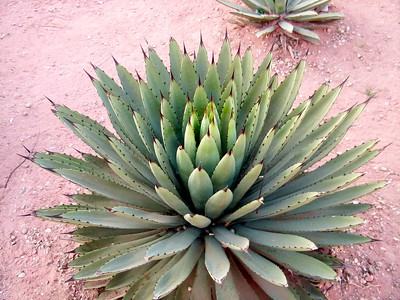
How does mezcal is produced?
There are different ways to produced mezcal. Talking about the traditional (artisanal) process, in general terms, it involves rough and roasting the agave leaves. Once the heads or pineapples (pencas) are cleaned, they get grinded.
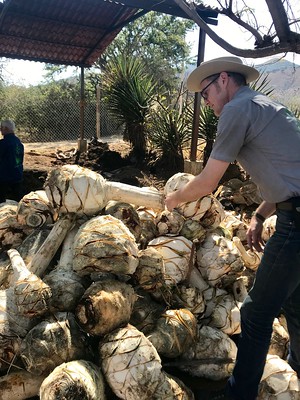
Agave hearts get cooked in pits in the ground then grinded to extract their juice. Then the liquid goes to fermentation and gets distilled twice in copper stills* or clay pots.
* An alchemical still or alembic is made of two vessels connected by a tube. It’s used for liquid distillation.

Tequila is produced in a similar way, see the difference here.
Is mezcal Mexican? - Mezcal origin
Yes, mezcal is an ancient Mexican spirit. According to some studies carried out by anthropologists from UNAM (Universidad Nacional Autónoma de México), this agave beverage was distilled by Mexicans in clay pots since 400 BC.
Later, the Spanish conquerors brought with them the distillation process (16th century). They realized Mexicans produced alcoholic beverages from agave and try it, but using their distillation process. If you consider the wide meaning of mezcal, every spirit distilled from agave, then the first mezcal got produced.
| Follow PackAndGo.info at: | |
| YouTube | @packandgo. |
| @packandgo.info | |
| X | @packandgoinfo |
| Bluesky | @packandgo.bsky.social |
| @packandgo.info | |
| TikTok | @packandgo.info |
The homemade production of mezcal is ancient in Mexico, but it became more important until the Mexican Revolution (1910-1920). However, its growth was very slow. As an industry, it started in the 18th century, when the distillation process got well known and popular in Mexico. The production of mezcal in an artisanal way was illegal, so everything was made clandestinely. The creation of the official Mexican standard and the appellation of origin (1994) were important steps to safely promote mezcal nationally and internationally.

Learn more interesting facts about mezcal here!
You can also check FAQ about tequila.
Are there different types of mezcal in Mexico?
Yes, there are different types of mezcal in Mexico. Types are defined by factors like the specific variety of agave used for its production, its aging time, production process, and what the Mexican Official Standard (NOM) says.
Based on the chosen agave to produce mezcal, the taste and smell you get. Tobalá, espadín and madrecuixe are three popular agave varieties used to produce mezcal.
Considering the aging process, there are three types of mezcal: young, aged, and extra-aged.
- Young mezcal is obtained directly from the distillation process. It’s light yellow color.
- Aged mezcal is stored in white oak or common oak barrels for at least two months. As a result, it gets a golden yellow color.
- Extra-aged mezcal has a maturation process of a year as a minimum. It gets an ocher brown color.
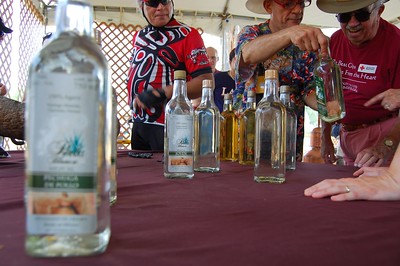
Based on its production process there’s minero (traditional), pechuga (breast), and abocado.
- Minero is the traditional mezcal. Its production follows an artisanal process that doesn’t involve electronic devices.
- Pechuga (breast) is produced following an ancient recipe from the Mexican state of Oaxaca. It involves a third distillation process in which a chicken, turkey, or rabbit breast is used to add smoky notes. The breast is hung inside the copper still so that the distillation steam comes into contact with it. That hot steam cooks the breast until it disintegrates. There are many recipes. Before the third distillation, other ingredients such as mole, tamarind, lemon, almond, walnut, guava, and more can be added.
- Abocado. It’s a type of mezcal that gets softened through the addition of natural ingredients like seeds, flowers, or maguey worms. Yes, the popular mezcal worms!
The Mexican Official Standard, NOM, establishes two mezcal types, pure and not pure. In the pure mezcal, 100% of the carbohydrates come from agave distillate. Not pure mezcal contains 80% agave carbohydrates and 20% carbohydrates from other substances allowed by the same organization.
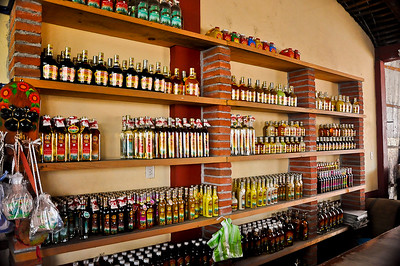
What does mezcal taste like?
Mezcal tastes like heaven! Ok, let’s answer objectively. Mezcal taste varies based on the agave that is used to produce the mezcal, its production process, and its aging time.
Mezcal’s most famous signature is its smoky taste. Those notes and their depth are the results of the way the agave is cooked (in pits in the ground). And smokiness can be emphasized through processes like the third distillation pechuga (breast) type adds to the mezcal production.
But mezcal flavor is not only smoky. It feels smooth and It can be earthy, sweet, fruity, or floral too.
Its flavor is smooth, finely oiled this combines with a specific and very pleasant aroma. In its aromas, very nice ingredients can be also present. Cocoa, light smoke, orange blossom, ripe fruit, etc.

What is the best way to drink mezcal? - How to drink mezcal in Mexico?
Mezcal flavor is a combination of nice elements. The objective is to give time to your mouth and palate to enjoy every one of its notes. Based on this, what Mexican bartenders recommend to drink mezcal is to slowly kiss it. Meaning you should drink it in small sips. That's considered the best way to drink it. Besides you can accompany it with some sips of water just to hydrate and clean your palate, for it to be ready to completely enjoy the next sip of mezcal, together with all its rich and tasty notes and aromas.
If you are into cocktails, these are the 5 best mezcal cocktails you can get.

Does mezcal go with chocolate?
Yes, mezcal goes with chocolate and life! Ok, again let’s answer objectively. Mezcal indeed combines well with chocolate. Experts on food pairing strongly recommend drinking mezcal while enjoying small pieces of chocolate, like truffles, tamarind, and sweets, like mazapán. They assure this combination produces tasty explosions in your palate. Just do it in proper order. First a sip of mezcal, after the chocolate or sweet.
You can also add a bit of mezcal to a cup of hot chocolate. This is a warm choice for Winter.

Conclusion
Mezcal offers to your palate a very sexy taste and experience. Mezcal is a tradition, a delicious sip of Mexico, variety of tastes and aromas. Mezcal is a temptation we recommend you not to resist. Remember, if you haven't had mezcal, you haven't lived!
Share your experience with us:
| Follow PackAndGo.info at: | |
| YouTube | @packandgo. |
| @packandgo.info | |
| X | @packandgoinfo |
| Bluesky | @packandgo.bsky.social |
| @packandgo.info | |
| TikTok | @packandgo.info |
It is official, Fanari has been occupied by Bulgaria!
- Details
- Written by: Gianna Esquivel
- Hits: 1012
Today we arrived in Greece! We are very excited and we are dying to see the Aegean Sea in person hahaha All those amazing pictures of the Greek beaches people post on the Internet are about to become real. We can’t wait! So we are heading directly to the beach! We will explore Northern Greece, starting with Fanari and its surroundings. Are you ready?

Where is Fanari?
Fanari or Fanarion (official name) is a small village located on the seaside in northern Greece. Take your map and follow these references. Based on Google Maps calculations, Fanari is:
- 386 km (4 hr. 35 min.) from Sofia (София), Bulgaria (BG).
- 201 km (3 hrs. 5 min.) from Plovdiv, BG.
- 106 km (1 hr. 26 min.), from Kardzhali (Кърджали), BG.
- 235 km (2 hr. 45 min), from Tekirdağ, Türkiye (TR).
- 88 km (1 hr 10 min), from Alexandroupoli, Greece (GR).
- 32 km (30 min.), from Komotini, GR.
- Xhanti 37 km (34 min.), from Xhanti, GR.
Fanari belongs to the Municipality of Komotini of the Regional Unit of Rodopi. It is a littoral settlement. It is 16 meters above sea level. Its population is estimated at 700 permanent residents.
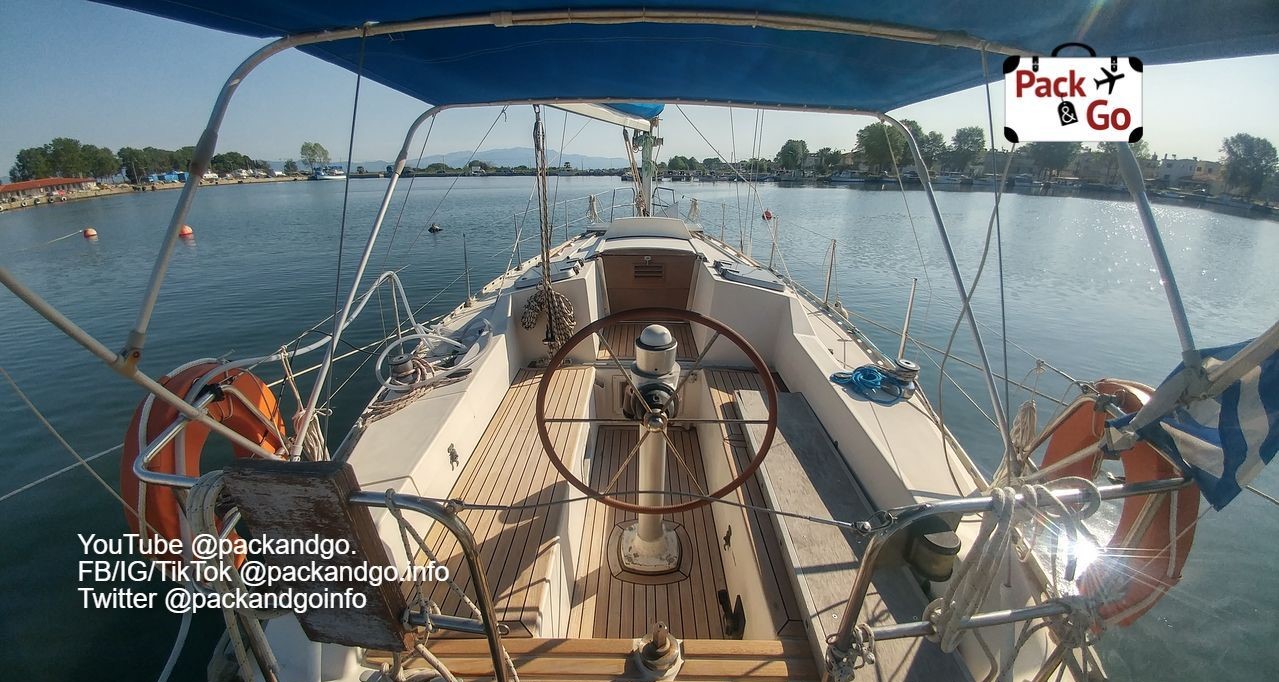
What is the meaning of Fanari?
Fanari means lighthouse. The name comes from the Greek φάρος (fáros). The village was named Fanari because its original center was established on the headland where the lighthouse was.
History of Fanari
When you arrive in Fanari village and see its beauty and the awesome Aegean sea, you barely reckon about its history. It’s like “Who cares? It is beautiful! That’s it!” hahaha. But come on! A bit of history does not hurt! hahaha.
Fanari's foundation goes back to 1923 when the Peace Treaty of Lausanne was signed. The objective was to establish the borders, exchange war prisoners, and relocate civilians after the war between Greece and Türkiye. Fanari and other villages around were founded by Greek refugees from Eastern Thrace, currently, Türkiye. Fishing, agriculture, and trade were the main activities in Fanari.
During World War II, Fanari, like many other Greek villages, was impacted by the German occupation. Locals took part in the resistance against the occupying forces. After the war ended, Fanari’s reconstruction and development took place. Fishing and agriculture (olive groves, vineyards, etc.) remained as main activities.
During the latest decades, Fanari has modernized and improved its infrastructure, transportation, and amenities. Residents’ quality of life has become better and the village more accessible for visitors. That is how, Fanari is now an important tourist spot in Rodopi, both for locals and tourists from neighboring countries like Bulgaria, Türkiye, Romania, and Serbia!
Since the moment we arrived in Fanari, the Bulgarian presence was very clear. We can say that roughly, from every 10 cars in Fanari, 6 had Bulgarian plates.
| Follow PackAndGo.info at: | |
| YouTube | @packandgo. |
| @packandgo.info | |
| X | @packandgoinfo |
| Bluesky | @packandgo.bsky.social |
| @packandgo.info | |
| TikTok | @packandgo.info |
What to do in Fanari?
Fanari is a small village ideal for you to relax and enjoy the beach, nature, and that slow pace coastal spots offer. It is the ideal destination if you are looking for a beautiful, comfortable, and quiet place to rest. Although the increase of tourists the village has experienced during recent years, it is not as crowded as other popular destinations in Greece. Besides, we arrived in May 2023 and we found only the local people and a few tourists, mostly Bulgarians. Some of them were there only for short stays, like a day or a weekend. May is still low season so if you arrive in July or August, for sure you will find more visitors.
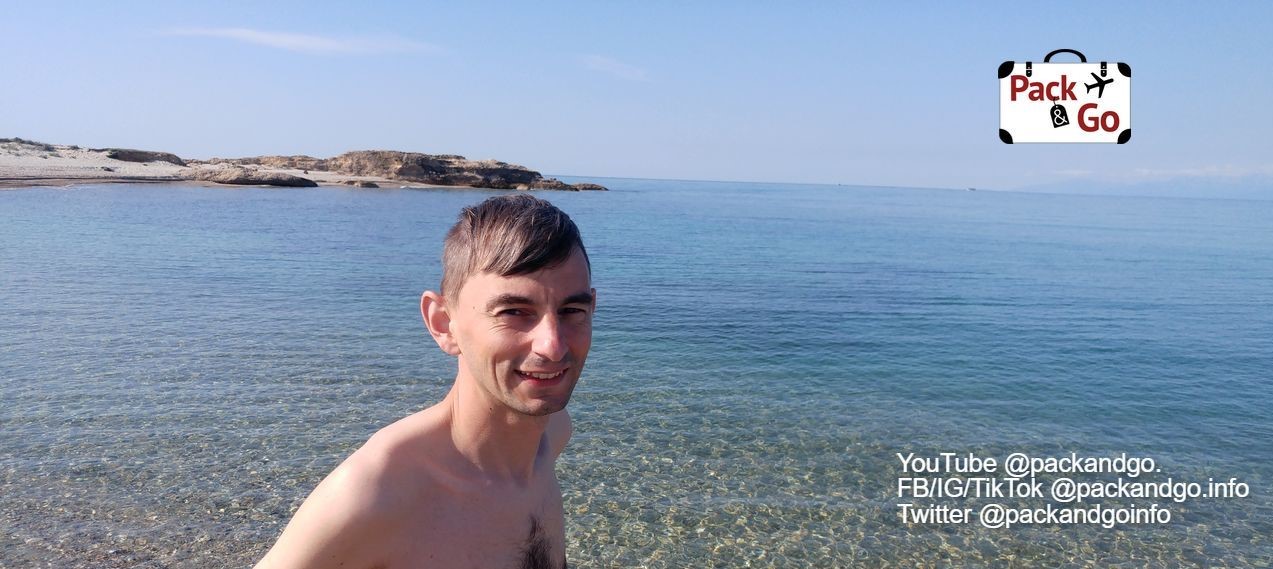
What to do in Fanari? Well, of course, you can explore the village and its surroundings, but you can also enjoy the awesome pleasure of doing nothing… Ok, nothing more than jumping into the sea, enjoying the beach, and fulfilling your soul with the beautiful landscape and your belly with delicious Greek food and drinks. This was a very tempting plan we did not refuse! Hahaha. Ok, here you have what to do in Fanari!
Swim and enjoy the beaches
Fanari owns beautiful beaches, one (the longest) has the blue flag tag, an indicator of quality standards and environmental safety. The beaches are pleasantly sandy! During May, the water is cool, some can say “still cold”, but we will say, just a little bit cold. And honestly, to have this beauty only for yourself, without sharing it with hundreds of tourists, is worth not waiting until the high season (Summer). The shallow waters of these beautiful beaches are a big plus for families, kids, and people who don’t know how to swim. The currents at the time we were there were very calm.
We were moving from beach to beach only to change the view. Here kind of our daily routine there:
- Beach at the port of Fanari. We visited it for an early swim. The only people we saw there, were local fishermen working on their boats and Bulgarian fishermen who enjoy this activity as a hobby. It was easy to enjoy the tranquility of this nice, sandy, and for moments, a bit rocky beach.
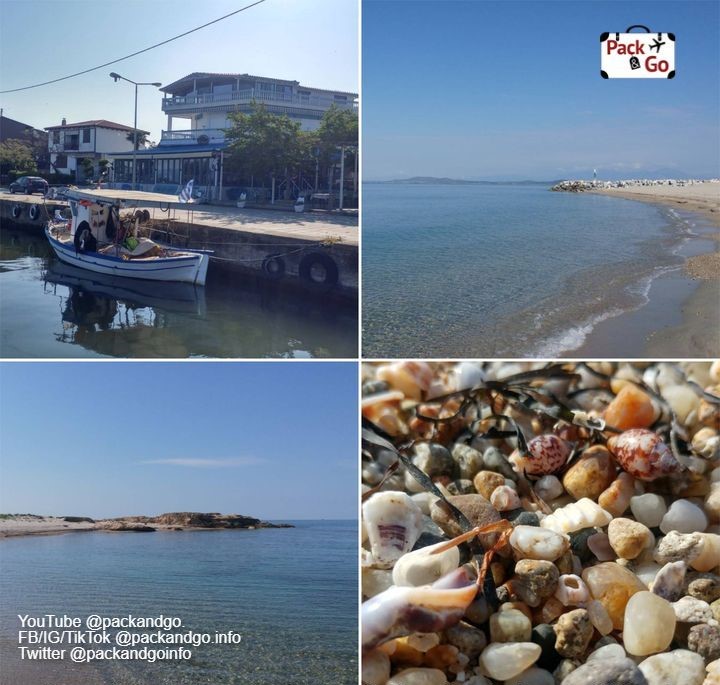
- Central beach. We moved to the central beach in front of the restaurants and cafes to have meals, and delicious hot coffee and cold Greek coffee (frappé, freddo espresso, or freddo cappuccino). Since the restaurants are here, they are a magnet for people. We were very lucky because, by the time we were there, neither the restaurants nor the beach were crowded. Only during the weekend, more visitors arrived to have a coffee or spend the day in the village.
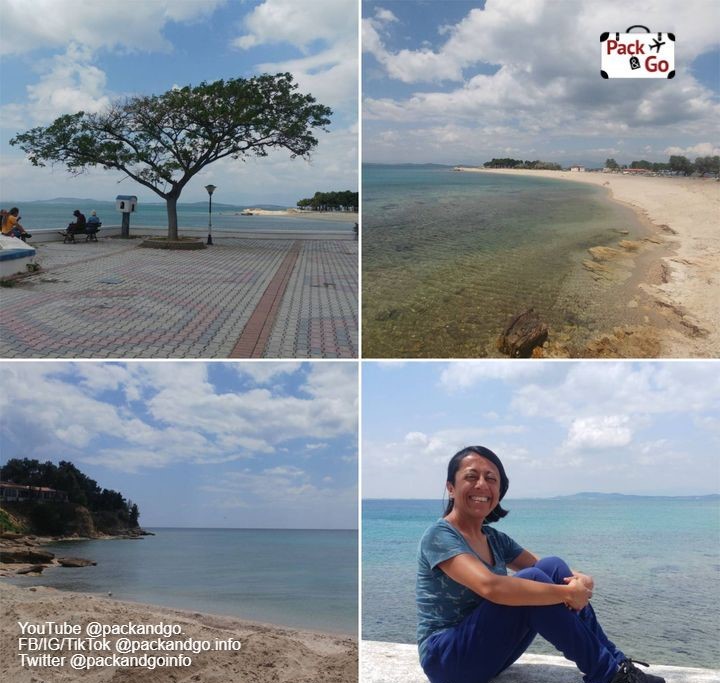
- Arogi-Fanari Beach. This is the longest beach in Fanari. After breakfast, we walked on this beach that connects Fanari with the nearby village called Arogi. You can walk as long as you want on this pleasant, sandy, and peaceful beach. The absence of commerce or big development around makes this area more secluded and tranquil. You only need to take with you water and sunblock! That is it!
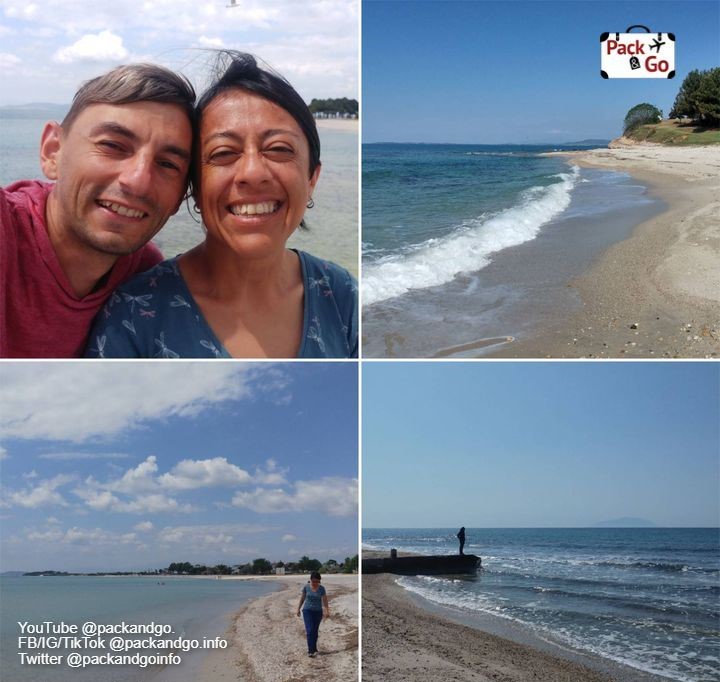
Fishing
We have not trained for fishing yet, but as we told you before, we found Bulgarian enthusiasts of this activity there. One day, while enjoying the sunrise, we greeted some fishermen in Greek, “Καλημέρα (Kalimera)!”. Then, they answered, “добро утро (dobro utro)!” hahaha. Come on! They were Bulgarians! Hahaha. They ruined what with thought was our first friendly encounter with Greek people. But they gave us a fun time and some cool tips for fishing!
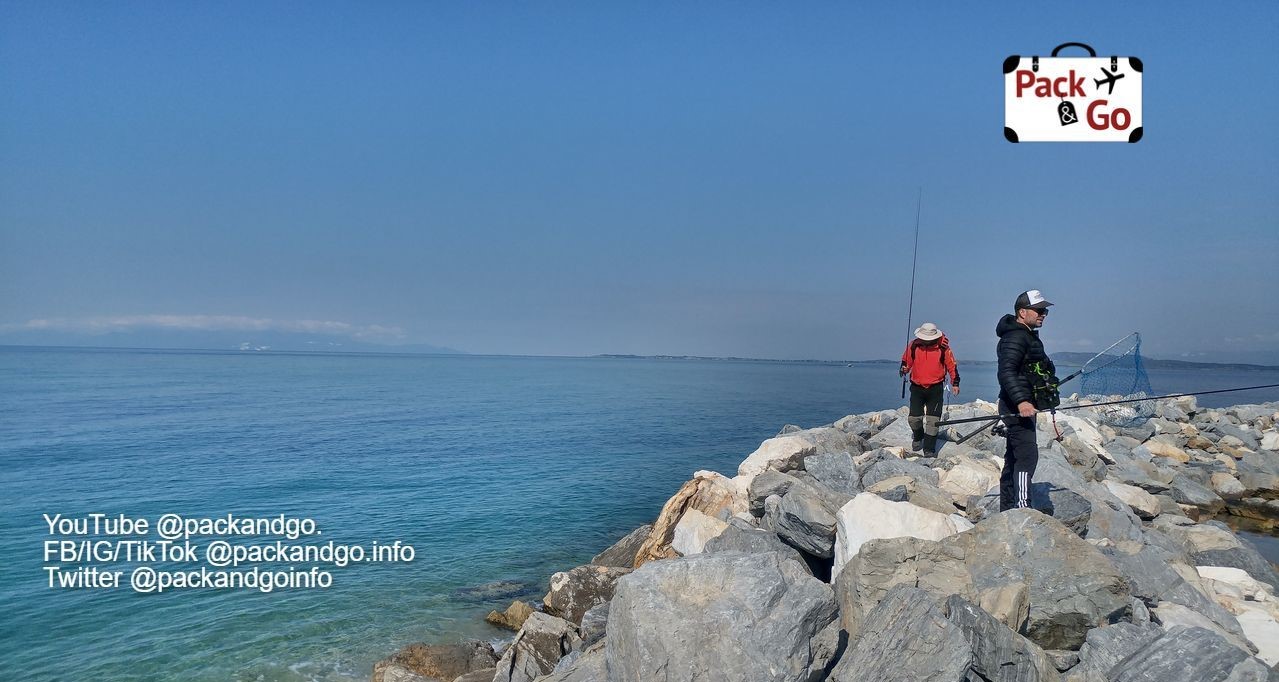
They were from the southern city of Kardzhali, BG. For them to visit Fanari is a relaxing hobby together with fishing. They like so much the shallow and clear waters of the Aegean Sea, so they come to spend long stays, especially during the Summer, but also a day or several hours only to relax, fish, and get back home (Bulgaria) with fresh fish for dinner. If you are into making new friends, meeting Bulgarians can be another cool thing what to do in Fanari, Greece hahaha.
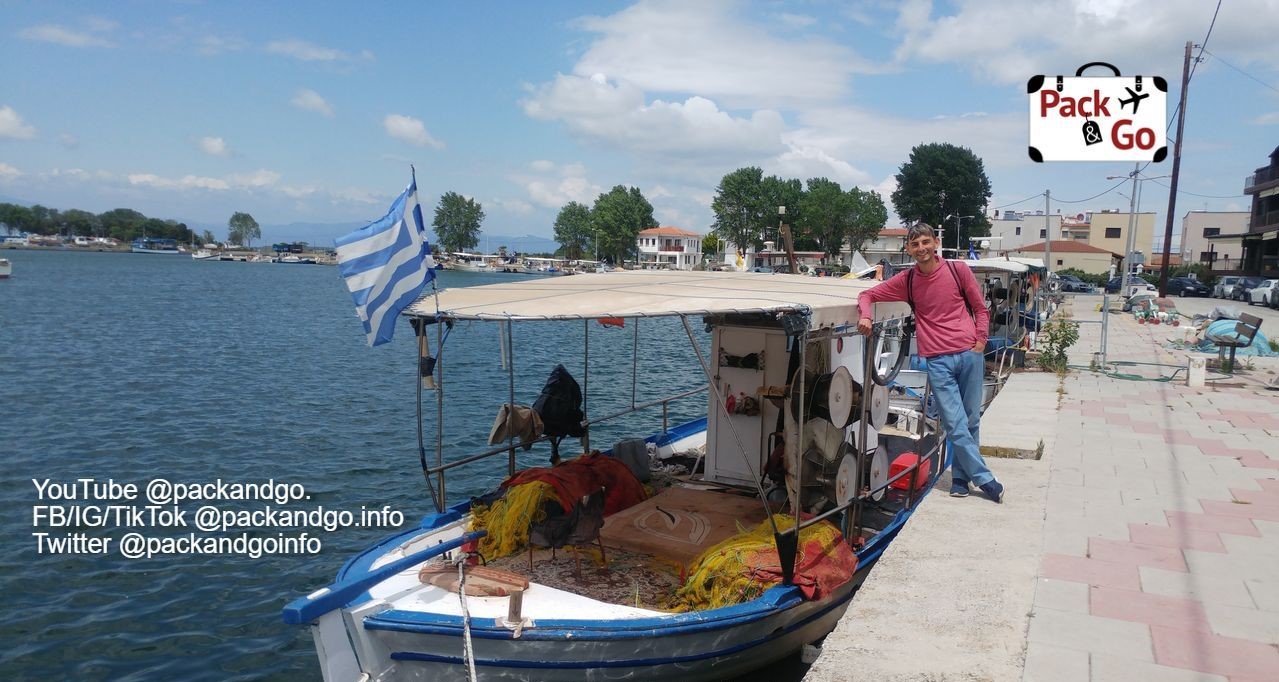
Cycling around
Tourists carrying their bicycles in their cars or campers was a constant while being in Fanari. Luckily, the landlord of the apartment we rented offered us bicycles to go around. It is not a rule but you can rent a bicycle or motorbike in some guest houses and hotels. It is a great way to go around Fanari village, its beaches and even to reach the next villages for more exploration. The terrain is mostly flat, the roads are good and we felt the whole area was pretty safe.
Sunset and sunrise spotting
Words can’t express how big fans of sunsets we are! The horizon in front of you, defined by the immensity and clarity of the sea, together with the changing colors of the sky that are reflected in the sea, wow! It is perfect! And very romantic too hahaha. Well, a big advantage of this village is that not only sunsets but also awesome sunrises can be seen in Fanari. We admired great sunsets from the beach at the port and lovely sunrises from the Arogi-Fanari beach. This is only a personal preference, you can choose your favorite place for spotting sunsets and sunrises, and get amazing postcards (pics).
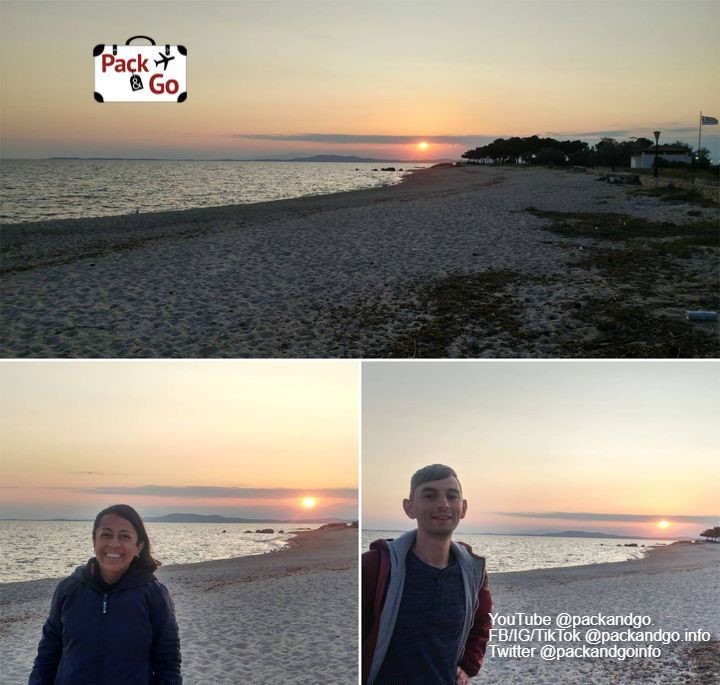
Taste Greek gastronomy
Fanari is a small fishermen's village, M is a fish lover so he expected to find an attractive variety of fish and seafood on the restaurants’ menus. Honestly, he was not impressed. The reason? He is Bulgarian and the fish offered in the menus are very common in the Black Sea coast too. You will find sardines and anchovies pretty much everywhere. There are other choices like burgers, pizzas, pasta, salads, pork, lamb, chicken, etc. We stuck to the Greek souvlaki and gyros. So, the fish variety was not impressive, but the Greek seasoning is good. You can eat tasty stuff from the morning to the night.
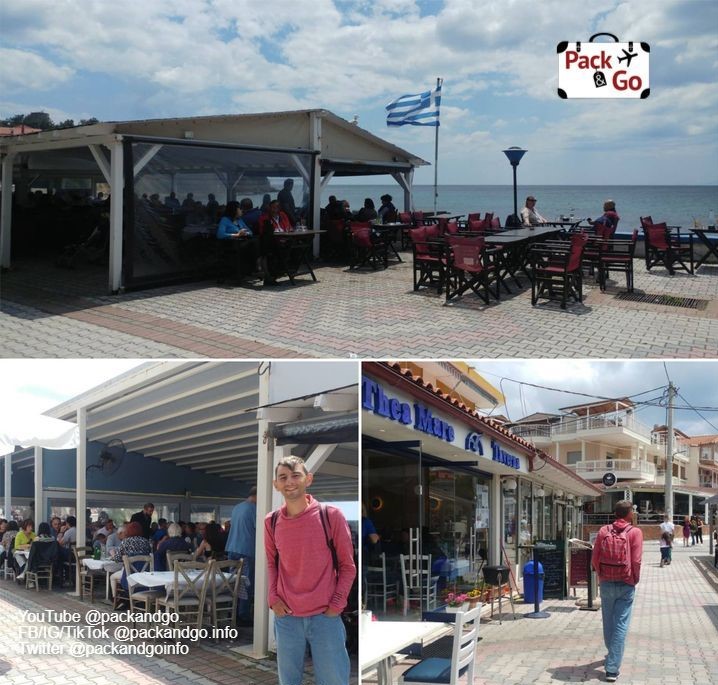
In a couple of restaurants, we saw that the fish was not fresh. The reason people gave was that during the low season, it is not lucrative to fish every single day. Ok, the problem for fish lovers is that being in a fishing village, you don’t feel like eating refrigerated fish. We choose places with fresh fish. Ultimately, it's a matter of taste.
One note here, menus are written in Greek, English, and BULGARIAN! So it is official, Fanari has been occupied by Bulgaria and locals know it well.
Drink Greek beverages
Beverages deserve a special mention because they are delicious and essential for Greeks' daily lives. The day can’t be started properly without a shot of hot coffee or even a cold one if the weather is already warm. Then, all along the day, you will see people drinking their different cold coffee choices, frappé, freddo espresso, or freddo cappuccino. They are delicious! Very early in this trip, we happily joined the Greek way hahaha. Later, after enjoying your meals, a shot of Ouzo or Tsipouro will be the digestive you need to reach “Nirvana” hahaha or just to hit the pillow to enjoy a nap. When it is to pleasures, Greeks are experts!
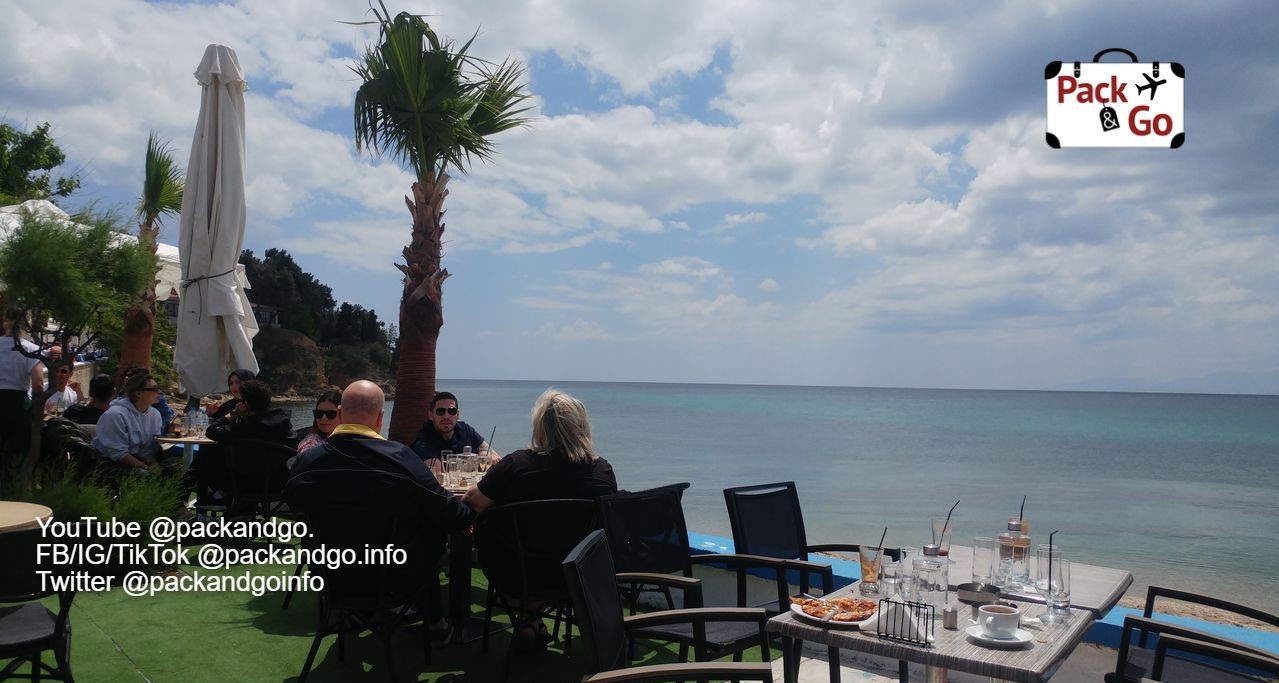
What to visit around Fanari?
If you want to explore more, the surroundings of Fanari will keep you entertained. This area is not as developed as other very famous cities or Greek islands. A large area houses natural ecosystems that have been left untouched to naturally flourish. Only 12 km north of Fanari is the Nestos National Park. You won’t see big and luxurious resorts, but nature and villages with a much more relaxed vibe. We love places like those still exist! These are our recommendations.
Porto Lagos and the Monastery Agios Nikolaos
Only 15 km (16 min. By car) northwest of Fanari, you will find Porto Lagos, where you can visit the Agios Nikolaos monastery (Xhanti region). It is an attraction because the complex was built on two small islets of the Porto Lagos lagoon, connected by a wooden bridge. On one islet, the Agios Nikolaos is. On the other, the Panagia Pantanassa chappel. The monastery seems to be floating framed by all that natural surroundings and enjoying an astonishing view, of the Thracian sea. It is an active place for believers and tourists.
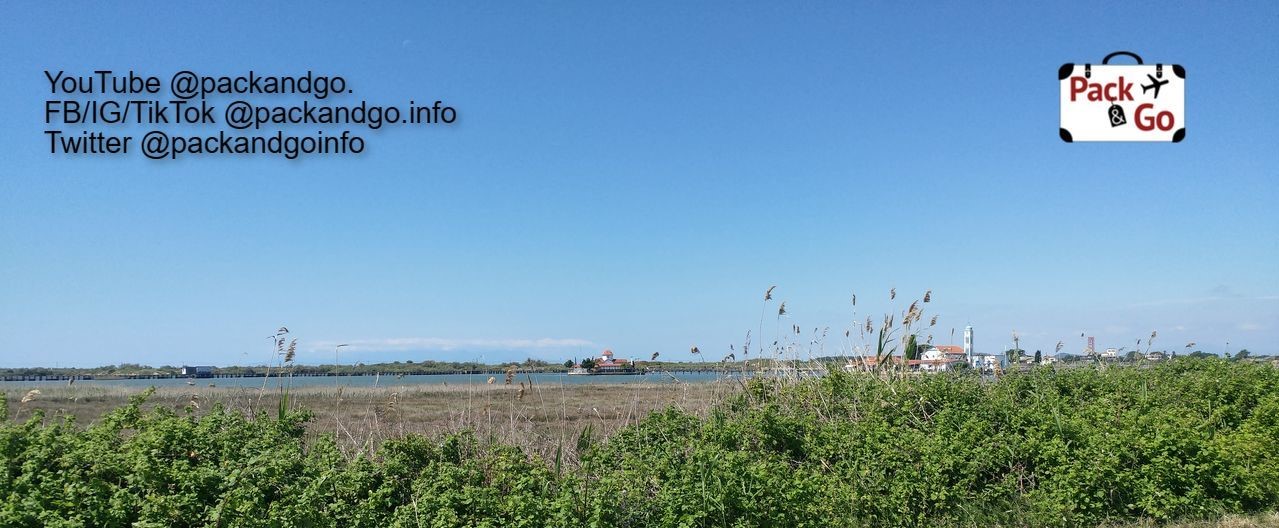
Lake Vistonida
From the moment you arrive in Porto Lagos, you will see Lake Vistonida. You can explore more of this beautiful lake, home to different and interesting fauna. It is an ideal spot for nature lovers, photographers, and bird-watching enthusiasts. Pink flamingos are beautiful and popular there (March-October). All the region where Lake Vistonida lays is a protected habitat.
Arogi village
Only 4 km east of Fanari, Arogi village is. It is another calm place, very similar to Fanari, but still a good alternative for exploration. Nature is the constant there, nice beaches, nature trails for hiking, traditional Greek architecture, tasty local cuisine, and beverages.
Where to stay in Fanari?
Accommodation in Fanari won’t be a problem! The village has a lot of guest houses, small hotels, apartments you can rent (different sizes and costs)., and a camping site. Just consider that during the low season, many of these places are closed, so the choices get reduced.
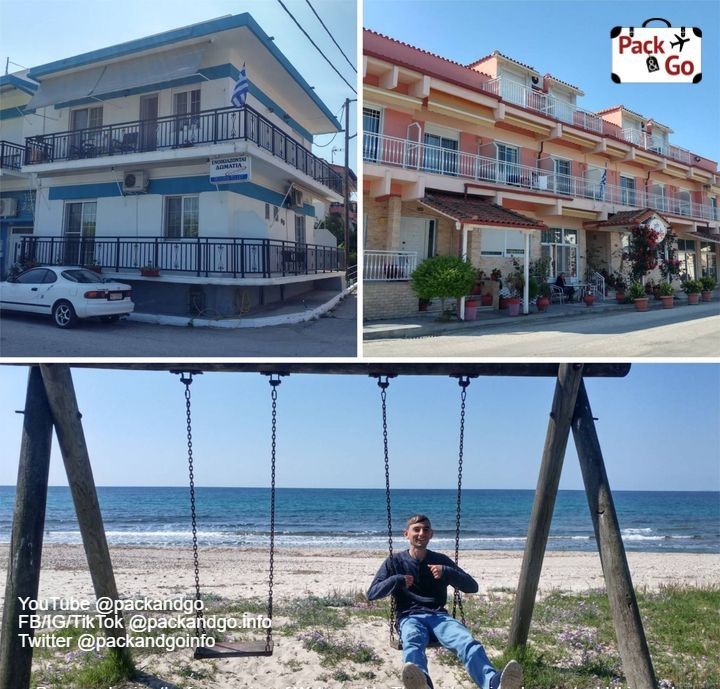
It is official, Fanari has been occupied by Bulgaria!
Bulgarians are big fans of Greece! Especially in northern Greece, we felt like we were still somewhere in Bulgaria. Daily, we found Bulgarians either at the beaches, on the road, at restaurants, in the accommodation, or in supermarkets. Greek people in the area also speak Bulgarian. We only can say, that the beauty of Greece is astonishing! It is impossible not to be conquered by it.
Conclusion
Fanari was our first stop on this trip through Northern Greece and it was perfect! We haven't enjoyed ourselves and relaxed as we did it here, a long time ago. The village has not the glam of the most famous Greek cities and islands but exactly that makes it very charming. We recommend you include Fanari in your travel list!
| Follow PackAndGo.info at: | |
| YouTube | @packandgo. |
| @packandgo.info | |
| X | @packandgoinfo |
| Bluesky | @packandgo.bsky.social |
| @packandgo.info | |
| TikTok | @packandgo.info |
Page 2 of 5
